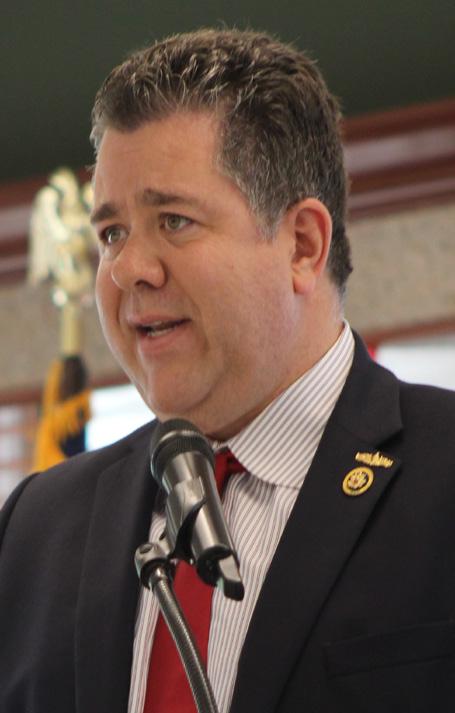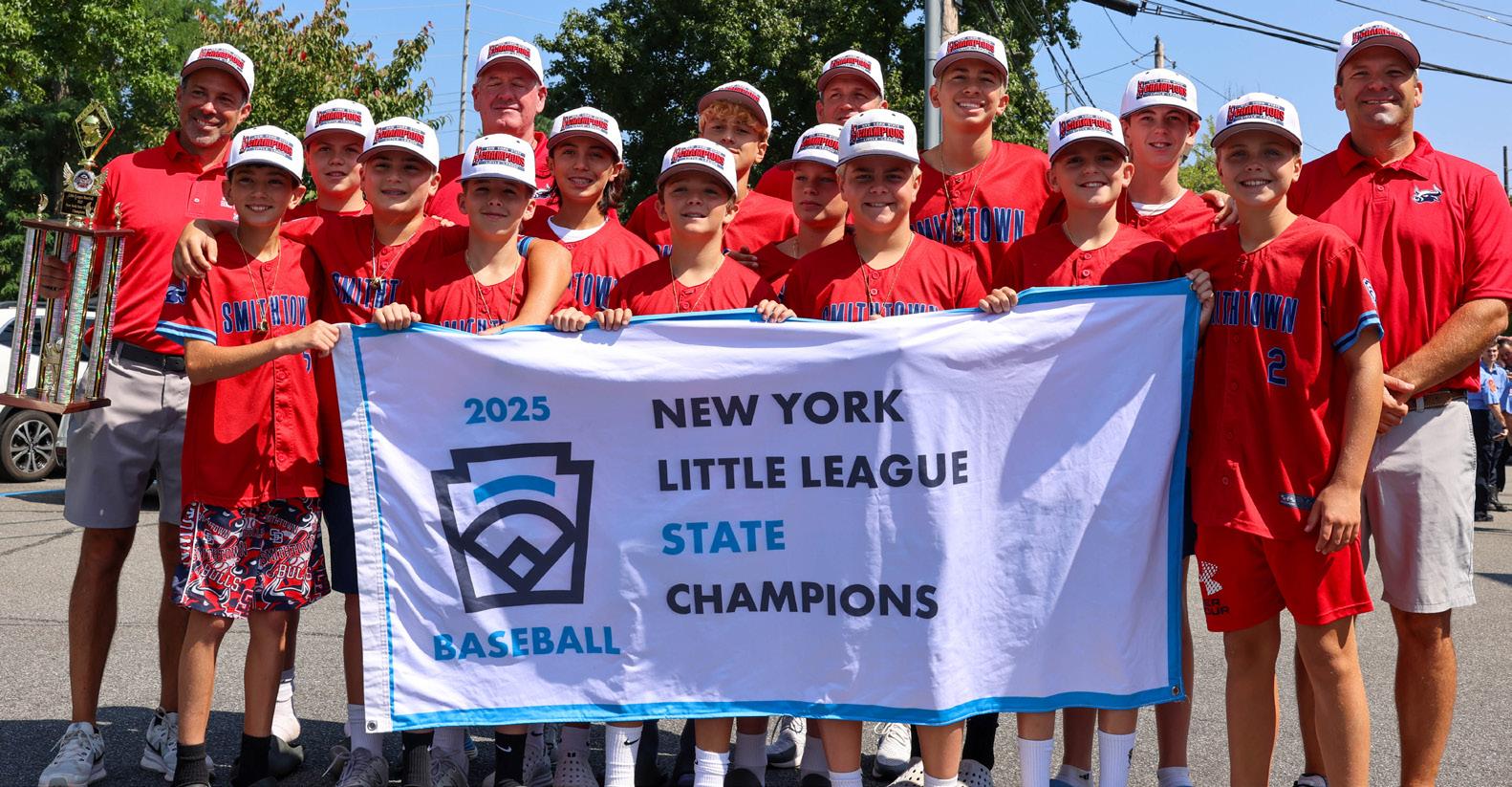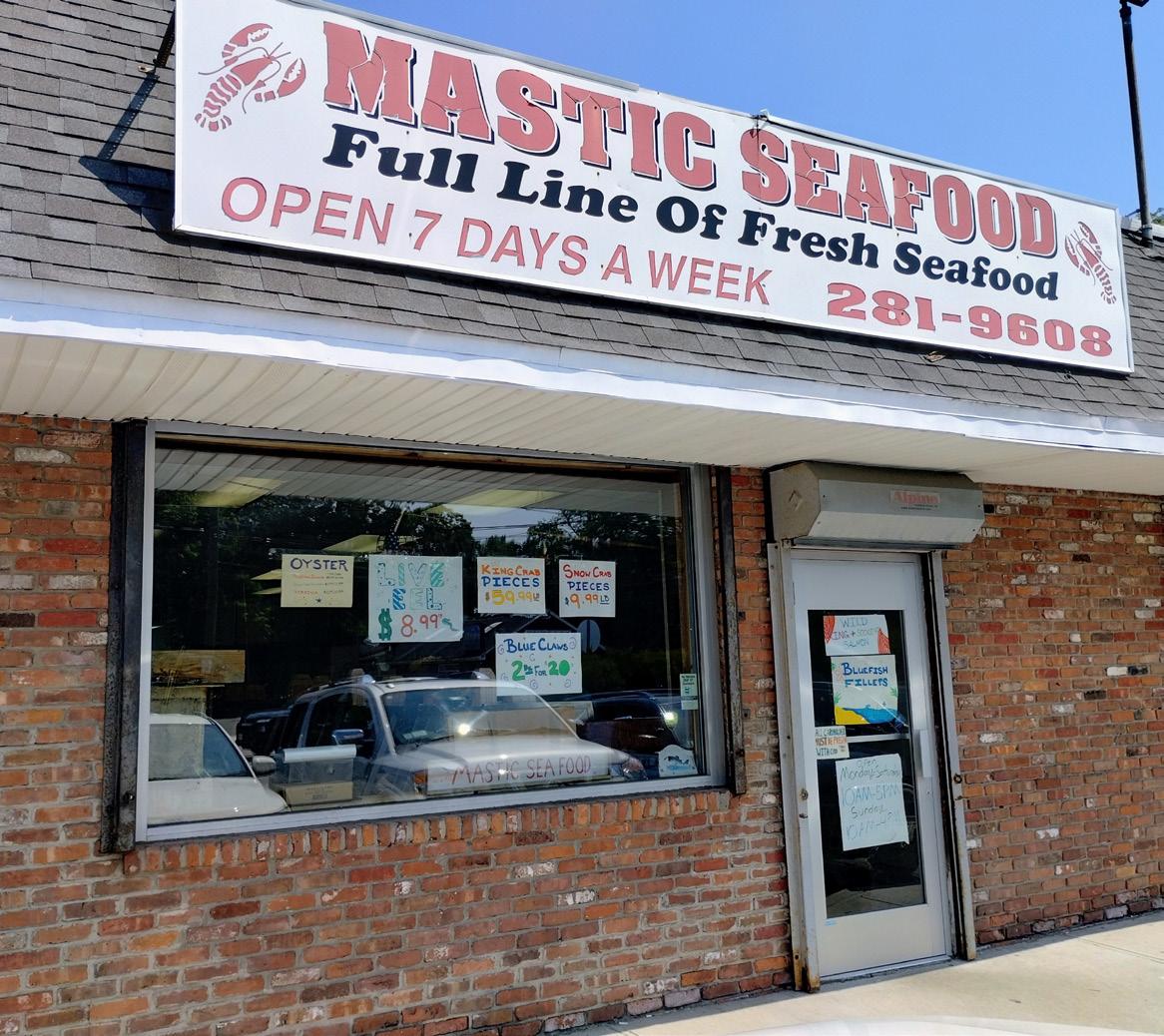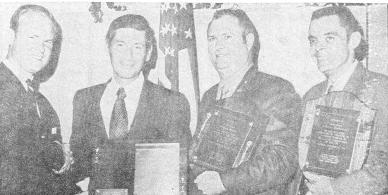








By Madison Warren
Suffolk
County Executive Ed Romaine (R-Center Moriches)
officially launched the county’s role in America 250 last week with a vibrant celebration at the historic Sagtikos Manor in West Bay Shore. The milestone event marked the beginning of Suffolk’s participation in a nationwide, multi-year initiative commemorating the 250th anniversary of the signing of the Declaration of Independence in 2026.
Set against the backdrop of one of Long Island’s most significant historic landmarks, the celebration brought the colonial era to life for hundreds of attendees.
Continued on page 4
By Matt Meduri
Developers looking to construct a Starbucks coffee shop near the Smith Haven Mall in Nesconset took their pleas for variances to the Smithtown Planning Board at a board meeting on Tuesday night.
The proposed location is on the southwest corner of Alexander Avenue and Middle Country Road (State Route 25). The current parcel is an undeveloped, wooded space across Alexander Avenue from Sonic, which proved to be a controversial proposal several years ago. The wooded lot is currently zoned as commercial property.
Continued on page 10





Mother's Day Brunch at Long Island Aquarium
Port Jefferson Summer Farmers Market at Harborfront Park
May 11, 10:00 AM, 12:00 PM, 2:00 PM, 4:00 PM
Route 110 Comic Show in Melville August 17, 10:00 AM to 3:00 PM
Bird and Breakfast at Connetquot State Park May 11, 8:00 AM to 11 :00 PM
Every Saturday and Sunday, May 18-November 28
9:00 AM to 2:00 PM
Fleece and Fiber Festival at Hallockville Museum Farm May 17, 10:00 AM to 4:00 PM
That 70’s Band “White Party” at Beach Club Estate August 20, 6:30 PM
Islip Farmers Market at Town Hall Every Sunday, June 7-November 22, 7:00 AM to 12:00 PM
Nesconset Spring Fling May 18, 10:00 AM to 5:00 PM
Bon Journey Concert at Heritage Park in Mt Sinai August 22, 7:00 PM
Jones Beach Air Show May 24-25, 10:00 to 4:00 PM
The Mix: Art Fest at Heckscher






PUBLISHER
Raheem Soto
EDITOR-IN-CHIEF
Matt Meduri
STAFF REPORTERS Cait Crudden
ART PRODUCTION
MANAGER
Sergio A. Fabbri
GRAPHIC DESIGN
Colin Herr
CONTRIBUTORS
PJ Balzer
Ashley Pavlakis
MANAGER
Tim Walz
DELIVERY PERSONNEL
PJ Balzer
Joe Cuminale




Madison Warren
OFFICE MANAGER & ACCOUNTS
RECEIVABLE
Kim Revere
PROOFREADER
Giavanna Rudilosso
SOCIAL MEDIA
Madison Warren
Published by Messenger Papers, Inc.
Thursday, August 14, 2025
Get ready, Smithtown — the summer is ending on a high note!
The Town of Smithtown, together with presenting sponsors A.J. Caro and Arrow Security, is proud to announce a FREE end-of-summer concert featuring the electrifying Nathan Dean & The Damn Band.
Date & Time: Saturday, August 23, 8:00p.m.
Location: Smithtown Performing Arts Center, 2 E Main Street, Smithtown, NY 11787
Phone: 631-724-3700 | Email: info@smithtownpac.org
Known for blending the raw energy of Southern rock with the heartfelt storytelling of country music, Nathan Dean & The Damn Band have earned a reputation as one of the hardest-working and most crowd-pleasing acts on the touring circuit. From Arizona honky-tonks to nationwide festivals, their live shows are a high-octane mix of grit, emotion, and pure fun — featuring original hits like Lonely Bed, Addicted to Sad Songs, and Settle Down.
Supervisor Ed Wehrheim (R-Kings Park) shared why this year’s concert will be unlike any other:
“Normally, we’d host Nathan Dean & The Damn Band outdoors for our end-of-summer celebration. But with unpredictable weekend weather all season and the incredible work happening at the Smithtown Center for Performing Arts — both in renovations and their outstanding upcoming lineup — this felt like the perfect opportunity to reintroduce our community to the Theater. Once complete, and with the Main Street revitalization project, the Smithtown PAC will serve as the anchor of our downtown. This concert is going to be the hottest ticket in town!”

Tickets: This is a free event, but tickets are required. Seats will be available through an online lottery system. Each person may reserve a maximum of two tickets via the Smithtown Performing Arts Center website. If you reserve tickets and are unable to attend, please email: info@ smithtownpac.org so your seats may be released.
Whether you’re a lifelong country music fan or just ready for a night of singalongs and boot-stompin’ good times, don’t miss this chance to experience Nathan Dean & The Damn Band in the heart of downtown Smithtown.
About Our Sponsor:
Proudly Celebrating 40 Years in Business
A.J. Caro knows what it means to invest in the community. Born and raised in West Islip, his vision transformed Arrow Security from a small local firm into a regional leader with seven offices, cutting-edge technology, and a “We Care” philosophy that’s more than just words—it’s action.
When he brought Arrow’s headquarters to Smithtown, he didn’t just build an office—he revitalized an abandoned lumber yard into a LEED Gold-certified symbol of sustainability on Main Street. His commitment mirrors our own: protect, preserve, and invest in the people and places that make Long Island thrive.
About the Band: Nathan Dean & The Damn Band
From Phoenix, Arizona, Nathan Dean & The Damn Band have been on the road since 2008, playing over 200 shows a year. Their sound—a mix of country soul, southern rock grit, and crowd-pleasing singalongs—has earned them a loyal fanbase across the U.S. bringing an authentic, high-energy performance that turns every show into a party.
The Smithtown Performing Arts Center is Located at 2 East Main Street in Smithtown. Phone: 631.724.3700 | Email: info@smithtownpac.org
Continued from front cover

The manor’s grounds were filled with the sights and sounds of 18th-century America — reenactors in period dress mingled with guests, live colonial music played in the background, and musket-firing demonstrations echoed across the property.
Guests also had the opportunity to sample dishes prepared from Martha Washington’s original recipes, adding a literal taste of history to the experience.
For Romaine, the event was not only a kickoff to a year-long commemoration, but also a reminder of the importance of knowing where we come from.
“We don’t do enough to remember our roots, where we came from, because when we know where we came from, we’ll have a much better vision of where we are going,” he told the crowd. Local officials from across the county joined him, using the occasion to formally align Suffolk with America 250, the national campaign designed to honor the country’s past while engaging communities in its future.
Sagitkos Manor proved to be a significant setting for this celebration. Built in 1697, the estate has witnessed centuries of American history. During the American Revolution, it served as the local headquarters for British forces under the command of General Sir Henry Clinton. Its historic significance deepened further in 1790, when President George Washington spent the night there during his tour of Long Island. Today, the manor stands as a reminder of Suffolk’s direct ties to the nation’s founding era, making it a fitting venue for the county’s America 250 kickoff.
The day’s programming struck a balance between education and entertainment. Reenactors portraying influential historical figures such as Thomas Jefferson and George Washington delivered stirring speeches that brought the ideals of the Revolution to life.
“I want each and every one of you to remember the importance of this anniversary that you are celebrating now and never forget the struggles that we had early on,” the actor portraying Washington told attendees.
Music played a key role in setting the tone for the event. A moving rendition of “God Bless America” by Suffolk County Sheriff’s Office Corrections Officer Megan Adamo drew applause from the crowd. The program concluded with a dramatic cannon blast — a symbolic gesture



honoring the Revolutionary era and the fight for independence.
This kickoff was just the first step in Suffolk’s plans for the America 250 celebration. Over the next year, the county will host a variety of events, including historical reenactments, educational programs, community festivals, and exhibits. The Suffolk County 250th Anniversary Commemorative Planning Committee — a group of more than 200 members representing diverse communities — will guide these efforts to ensure that residents across the county can participate.
Romaine also took a moment to thank those who brought the celebration to life.
“Thank you to the committee for the 250th anniversary of our independence, and for all those who have served our history and remind us of the greatness of this nation and the struggles and sacrifices that brought us to this day,” he said.
Organizers hope these events will inspire residents to explore Suffolk’s Revolutionary-era sites, learn more about the area’s role in the nation’s founding, and reflect on how America’s history shapes its future. As the county joins communities across the country in honoring this milestone, Suffolk’s commemoration of America 250 promises to be both a tribute to the past and a celebration of the shared values that continue to unite the country.


By Julia Katz
If Assemblyman Zohran Mamdani (D-Astoria) becomes New York City’s next mayor, Suffolk County Executive Ed Romaine (R-Center Moriches) (pictured right) says he’ll be standing by with an offer for the city’s businesses: move east, pay less.
Speaking on WABC 770 AM’s Cats Roundtable with Manhattan business tycoon John Catsimatidis, Romaine promised tax breaks to any companies willing to set up shop about 70 miles away on Long Island.
“If Mr. Mamdani wins, I’m going to encourage many of the corporations that do business in New York City to come to Suffolk. We’re going to give them tax breaks. They’re going to be able to do better,” he said.
Catsimatidis noted that Florida officials have been trying to lure New York City CEOs south.
Romaine’s pitch? You don’t have to move that far.
“Come out to Suffolk,” he said.

Mamdani, 33, is running on a platform of making New York more affordable. His big-ticket promises include free bus service, universal childcare, city-owned grocery stores, and more affordable housing. To pay for them, he wants to raise about $9 billion in new taxes on corporations and the wealthiest New Yorkers. That would mean matching New Jersey’s 11.5% corporate tax rate and adding a 2% tax on incomes above $1 million.
Romaine thinks that plan would speed up the city’s existing population and business exodus, already fueled by congestion pricing, the commuter tax, and the high cost of living.
“The taxpayers who pay the taxes, how much are they going to put up with?” he asked, adding that these policies “undercut and hurt our communities.”
Some in the business world agree. Mark Jaffe, president of the Greater New York
The Suffolk County Water Authority is warning all customers that water usage remains at dangerously high levels as hot, dry weather continues across Suffolk County. Peak demand has reached 520,000 gallons per minute multiple times this summer, pushing the system to its limits.
SCWA has experienced several consecutive weeks of high water use during the overnight hours and early morning when irrigations systems are typically in use. When this occurs the water storage tanks in several areas start the day at low levels and are taking longer than expected to recover. These tanks are critical to keeping water pressure at required limits across the system. The weight of the water in the tanks creates the pressure that pushes water through the distribution network. When tank levels drop too low, that pressure drops as well—meaning homes and businesses may see reduced flow, and in the event of a fire, emergency services may not have the water they need to respond.
With every SCWA well, pump and treatment facility operating at full capacity, there is no remaining infrastructure to meet this high demand.
“Unfortunately, not enough of our customers have been cutting back on their water use,” said SCWA Chairman Charlie Lefkowitz. “If this continues, we’ll see more drops in water pressure, and our ability to respond to emergencies like fires will be at risk.”
The Stage 1 Water Alert, first issued on July 23, remains in effect for all SCWA customers, including residences, businesses and golf courses. SCWA is imploring customers to refrain from all lawn watering until further notice. If watering is absolutely necessary, customers must follow the odd/even lawn watering schedule:
• Odd-numbered street addresses water only on odd-numbered calendar days
• Even-numbered street addresses water only on even-numbered calendar days
• No lawn watering between 10:00a.m. and 4:00p.m.
“Our crews are doing everything possible to keep water flowing, but this is a shared responsibility,” said SCWA Chief Executive Officer Jeff Szabo. “If customers don’t take these restrictions seriously, we risk widespread pressure drops that could leave firefighters without the water they need in an emergency. This is all about public safety.”
The long-term forecast continues to call for hot, dry conditions, meaning demand will remain high unless customers take the restrictions seriously.
For more information and water-saving tips, visit www.scwa.com/conservation or call SCWA Customer Service at (631) 698-9500.
Chamber of Commerce, said it’s no shock that Suffolk would try to benefit.
“If someone is going to raise taxes, it will be advantageous to neighboring cities,” he said. But Jaffe also questioned whether Mamdani will win in November, calling him “an idealist” and stressing the need for a “pragmatic mayor.”
Still, Mamdani (pictured right) is gaining ground. He beat former Governor Andrew Cuomo (D-Sutton Place) in the Democratic primary by twelve points, and a recent Zenith Research/Public Progress Solutions poll puts him at 50% favorability heading into the general election. His spokesperson, Dora Pekec, fired back at critics, saying, “Working people are being pushed out of the city they built, and it’s because of corrupt politicians like Andrew Cuomo and Eric Adams (D-Brooklyn).”

Romaine, a Republican, isn’t convinced Mamdani is ready for City Hall.
“He does not have the life experience and wisdom needed to gain perspective on what works and what does not,” he said.
Not everyone sees disaster in Mamdani’s plans. Caroline Weaver, founder of The Locavore Guide, said, “It’s too soon to panic,” adding that small businesses might thrive in a city focused on affordability.
Still, she doesn’t think leaving is the best answer: “Small businesses cannot survive in a city that prioritizes corporations and billionaires, but there’s got to be a way everyone can co-exist functionally.”
Whatever happens in November, Suffolk County is positioning itself as a readymade, business-friendly backup plan for any New York companies looking to pack up and leave.



August 14, 2025
The four-way New York City Mayoral race is heating up and while the result will have massive effects on the Big Apple’s future, the immediate bedroom communities of the nation’s largest city will certainly feel shockwaves thereafter
Suffolk and Nassau counties supply New York City with a big chunk of its commuters and tourists, and the city’s last decade of consternation and social metamorphosis has already affected Long Island.
Now, anticipating a victory of Assemblyman Zohran Mamdani (D-Astoria), Suffolk County Executive Ed Romaine (R-Center Moriches) is already setting up Suffolk to catch some of the fallout in the form of tax breaks to companies looking elsewhere.
Mamdani’s self-proclaimed status as a Democratic Socialist is the cornerstone of his campaign that promises city-owned grocery stores, rent controls, housing expansion, free city bus fares, among others. If elected, Mamdani will raise the corporate tax rate to match the 11.5% rate in neighboring New Jersey. The tax hike would bring in a projected $9 billion to pay for his cornucopia of promises. His plan also includes a tax on the wealthiest 1% of New Yorkers - those who earn above $1 million annually - at a 2% flat tax.
Mamdani has remained willing to negotiate on several of his policies, but remains steadfast in his affordability and taxation agenda.
By incentivizing businesses to Suffolk, Romaine hopes to dissuade them from moving to Florida, where many New York City businesses went during the mayoralty of Bill deBlasio (D), who pursued similar, yet less intense, initiatives that Mamdani has foreshadowed.
Romaine also fears that the current population exodus afflicting New York would only worsen if Mamdani wins. He also doesn’t think that Mamdani, 33, has the experience to run the largest city in the U.S.
We think Romaine’s offer is an appropriate “ounce of prevention.” While some businesses might decide to permanently leave New York if Mamdani wins in November, keeping some of them downstate would invariably help Long Islanders who commute, while also sparing them of the congestion pricing commuter tax and the dangerous state of some parts of the subway system.
Moreover, it would likely be a boon to Suffolk’s own economy. While no specific numbers have been discussed, it’s likely something that could be afforded even with tax breaks, with current corporate tax rates in mind.
Suffolk does not have its own corporate tax rate. Instead, it relies on the New York State Corporation Franchise Tax. The graduated tax has rates that typically range from 6.5% to 7.25%. For tax years beginning on or after January 1, 2021, and before January 1,
2027, the tax rate on the business income base for taxpayers with a base of more than $5 million is 7.25%. General business taxpayers pay a rate of 6.5%.

Qualified New York manufacturers, emerging technology companies, cooperative housing corporations, and small business taxpayers are exempt from the capital base tax of 0.1875%. Corporations conducting business within the Metropolitan Commuter Transportation District (MCTD), which includes Suffolk County, are subject to an MTA surcharge on top of their NYS corporate franchise tax liability. The surcharge is set annually by the Commissioner of Taxation and Finance. The rate is fixed at 30% for Article 9-A taxpayers. A corporation must be in receipt of at least $1,283,000 - until January 1, 2026 - for this surcharge to apply.
Meanwhile, in New York City, the corporate tax rate stands to almost double if Mamdani wins. The current general rate is 6.5%, businesses with a base of at least $5 million face a 7.25% rate, financial corporations see a 9% rate, emerging tech companies see a 4.875% rate, and qualified manufacturers face a rate from 4.425% to 8.85%.
Therefore, other tax breaks within Suffolk’s purview would have to be considered. However, we find that the cause is worthy enough for exploration. Keeping New York businesses here would certainly help Suffolk workers who currently depend on them, while also potentially serving as an economic booster shot to the region. Corporations who might have more of their workforce remote or out-of-state could still bring a draw to Suffolk, courtesy of Islip MacArthur Airport (ISP).
We are concerned, however, about the scale of what this could mean. Would the physical, in-person workforce expand in Suffolk, or would these jobs not add much strain to our already-suffocated infrastructure? Would this also strain the housing market even further here? The exodus from New York City under the deBlasio and Adams eras have exacerbated the housing market on Long Island. Many have struggled competing against transplants from the city outbidding Long Islanders with sizable cash offers above asking price.
We’re thinking out loud here, and there’s clearly still more of this plan to be disclosed. We’re certainly in favor of Suffolk looking to help shoulder the burden of what fallout seems to be expected in the event of a Mamdani win, and we certainly think that Romaine has the best intentions in mind here as well. We look forward to hearing and seeing how this plan would be implemented and what it would mean for our region.
There are two kinds of problems in government: the kind that require resources and the kind that require a decision.
The collapsed dam linking Brookhaven and Smithtown falls squarely into the second category. The heavy rains that washed out the structure last August turned a scenic pond into a mudflat and severed a transportation link.
The fix isn’t a mystery. The money isn’t a mystery. The only mystery is why it hasn’t started.
FEMA will pay for roughly 75% of the reconstruction. That’s not speculation; it’s the standard formula for federal disaster reimbursement. The remaining share can be split between the Town of Brookhaven, Suffolk County, and any other willing partners. Supervisor Dan Panico (R-Center Moriches) and Councilmember Jonathan Kornreich (D-Stony Brook) have made clear they are ready to move forward under that arrangement.
The catch is one that doesn’t cost a dime: the property owner at the time of loss must sign the FEMA application. Without that, there is no reimbursement, no shovels in the ground, and no restored pond.
Instead of a signature, we’ve seen proposals that would make a Wall Street banker blush. First, the Ward Melville Heritage Organization (WMHO) suggested dividing the bill eight ways among government entities and nonprofits, each kicking in about $540,000. That plan depended on multiple agencies stretching their legal authority to spend taxpayer dollars on private property. Then came a new plan: WMHO would put up $1 million, and residents would be encouraged to pressure the Town and County for the rest.
Both ideas share one fatal flaw — they walk away from guaranteed federal funding in favor of speculative, patchwork fundraising. That’s not fiscal responsibility; that’s gambling with taxpayer money.
Meanwhile, the community lives with the consequences: detoured traffic, a damaged historic site, and a pond that has gone from postcard beauty to vacant-lot blight. Businesses lose foot traffic, emergency services lose time, and residents lose patience. Every week that passes without action is another week of compounding costs — financial and otherwise.
The Town has offered solutions to remove obstacles. They’ve proposed taking a quit claim deed to relieve insurance concerns. They’ve offered to share un-reimbursable costs. They’ve even opened the door to state involvement, if necessary, though that path would be slower and more complicated. The sticking point remains the same: no signature, no FEMA funds.
Some disputes are about competing visions. This isn’t one of them. There is no alternative “vision” that makes bypassing a 75% reimbursement rational. The only alternative to cooperation is a drawn-out legal fight, higher costs, and a project that should be in progress still sitting idle.
The issue isn’t at Town Hall — it’s at the signature line. Panico’s position is simple: take the federal money, fix the dam, and restore the link between two towns. Anything else is needless delay at the public’s expense
The arithmetic is clear. The choice is clear. And the responsibility for inaction is just as clear.
Raheem Soto Publisher, Messenger Papers

By Julia Katz
I’ll never forget the first time I saw the Capitol Building: January 21, 2025, my first day of work. I had just navigated the Metro alone for the first time, a small victory. Still overwhelmed from my first weekend in D.C., which coincided with the Inauguration, I found myself unexpectedly emotional as the Capitol came into view, captivated by the white dome.
After interning in a district office for a member of the House last summer, I assumed this experience would be similar. Within hours of walking into the D.C. office of different member, I realized how wrong I was.
I didn’t know then that my time on the Hill would challenge me in ways I hadn’t anticipated. For a world that insists upon tolerance, I learned how quickly people abandon it when they don’t like who you work for.
People don’t realize who’s on the other end of a congressional phone line. It’s not a Chief of Staff or a Communications Director picking up the phone. It’s interns, often college students, full of hope and eager to contribute, still trying to find their place in the system. I – a young, conservative woman - was one of them, excited to be in D.C., proud to represent my values, and ready to work hard.
What I received in return was often disproportionate to my excitement — not because of anything I did, but because of who I represented. Rage, misogyny, and ideological hatred poured in from strangers who didn’t even know my name.
As an intern during a wave of bold, polarizing decisions by the new president, I found myself fielding far-from-typical calls that quickly became routine. Each day brought a new issue. Common topics included: “What’s the Congressman’s stance on Trump pardoning January 6 rioters?”; “What’s he doing about tariffs?”; and, “Why is he trying to remove our Medicaid?”
The day Elon Musk entered the White House marked the start of what felt like six weeks of mental unraveling. From 9:00 to 5:00, the phones never stopped—four lines lit up constantly, voicemails stacked up, and some calls felt like a personal attack. Most days, I barely caught my breath. It wasn’t just exhausting; it was dehumanizing. People called me a disgrace to women, told me to kill myself, and accused me of being a Nazi.
I’m still stunned by how vicious people can be when they forget there’s a human on the other end of the line, regardless of political views. Our supervisor reminded us to stay calm and avoid giving callers emotional ammunition, but what stuck with me most was how often my gender became a target.
Some of the harshest callers were women, hostile simply because I was one too. To them, the idea of a young woman working in a Republican office was offensive. Just answering the phone made me a “traitor to my gender.” They assumed everything: my beliefs and my morals and used those assumptions to justify cruelty. What made it even worse was knowing that, from time to time, there were family friends on the other end of the line, tearing me apart without realizing who they were speaking to.
Did they know it was me? Of course not. It took everything in me to stay quiet, to resist the urge to reveal my identity. They would never say those things to my face, or to anyone, for that matter. But the anonymity of the phone gave them a sense of power. I’m certain they’d be mortified if I ever confronted them. Then again, confidentiality is part of the job.
My mind constantly raced with those calls. Being called a “Nazi” left a substantial mark on me. Having no way to defend myself was one of the hardest things to carry.
Somehow, through that fog, I found pieces of light. I leaned on the other two interns. We were in it together. Their presence, their humor, and our Metro rides home gave me something to look forward to. As the volume of calls began to dip around the spring, I could finally focus on the work that brought me here: policy - drafting memos, reviewing markups, and attending briefings.
In early April, I had the chance to attend an event for conservative female interns. The room was filled with influential female conservative leaders, many of whom had once walked the same path as Hill interns.
During the Q&A session, the conversation turned toward perseverance and finding your place in challenging environments. I raised my hand and asked, “I hope this doesn’t come off the wrong way, but as a former
conservative female intern, was there ever a moment when it all just felt like too much, when you thought about giving up? Because the calls I’ve been taking lately have been anything but encouraging.”
The room fell silent, followed by a wave of nodding heads, dropped jaws, and a collective sigh. I had said aloud what many had been carrying quietly. I gave a voice to a shared struggle, one we had all felt, but none had dared to speak. That moment sparked a powerful and honest conversation that brought much-needed validation to everyone in the room.
Camaraderie bloomed instantly. As we spoke, we realized just how many of us had been having the same experience: feeling alone and questioning ourselves yet pushing forward. After the event, dozens of women approached me. They wanted to exchange numbers, grab lunch, and invite me to future gatherings. Suddenly, the loneliness I had been feeling for months was replaced by a sense of belonging.
I kept thinking, “Where was this in February? Why now?” But it didn’t matter. I left that day with a lighter heart and a stronger sense of self. I was no longer the odd one out. I had found my community.
Capitol tours became a breath of fresh air. Guiding families through the building reminded me that despite everything, people still believe in something bigger. Guests often emailed my supervisor to thank me, some bringing me to tears. These moments restored a piece of myself that the phones had stripped away.
When I first arrived on the Hill, I was full of awe and excitement, unaware of what I was walking into. Looking back, I’m glad I didn’t know. If someone had warned me in December about what was coming, I might’ve run the other way. But enduring that storm was the only way to see the brighter sun. I can’t imagine not having had this experience. I’m not the same person I was when I started.
When my internship ended, something felt off. The government was in turmoil, and I couldn’t stop thinking about what the next group of interns would walk into. Just five days before my last day, a new intern had started. It was surreal knowing how unaware she was of the storm we had just weathered. Coincidentally, she was also the only female intern in her class, the one following mine. But unlike me, she wouldn’t have to face it alone. She had something I didn’t have during my hardest days: me.
Even if she encountered the same dismissiveness or disrespect from others, I could be the support I once wished for. Every time she reached out, which became almost weekly, I felt a quiet sense of comfort. In a way, it felt like a season of redemption. She was better equipped to handle the weight of it all, not because the job had changed, but because she had someone to turn to who truly understood.
After the other interns left, it was just me for the first time, and while I wasn’t afraid, it felt unfinished. The three of us had gone through something intense, something only we understood. Now I was closing it out alone.
But in that solitude, I saw how far I’d come. I wasn’t that wide-eyed intern anymore. I was still standing, more grounded, confident, and committed to the values that brought me here.
I left the Hill stronger, though not unscathed. Those responses I once dreaded taught the importance of standing firm in your beliefs, especially when the world tries to shame you for them.
In a few months, I heard thousands of opinions from constituents and gained a deeper understanding of diverse perspectives. I learned to think more critically and be mindful of how my words land.
I believe in public service, I believe in D.C., and I believe now, conviction isn’t weakness: it’s strength. Conservative women belong here. And the next time someone picks up the phone on the Hill, I pray they’re met with respect because they might be someone like me: hopeful, determined, and ready to serve our great nation.
Julia Katz is a senior at James Madison University and is a recent graduate of the Suffolk County Legislature Page Program.

Thursday, August 14, 2025
By Cait Crudden
Congressman Andrew Garbarino (R-Bayport) and Congressman Ritchie Torres (D, NY-15) have announced the bipartisan reintroduction of the Saving Vet Halls Act, legislation aimed at preserving and modernizing the facilities of local Veterans Service Organizations (VSOs) across the nation.
The measure would create a federal grant program to address the infrastructure and technology needs of VSOs, organizations such as the American Legion, AMVETS, and Veterans of Foreign Wars (VFW), which provide critical services to veterans, servicemembers, dependents, and survivors.
Many VSO posts, often the heartbeat of their communities, face growing challenges due to aging infrastructure, limited resources, and rising maintenance costs. Without support, some have been forced to scale back services or close their doors entirely.
“Veterans’ halls play an important role in our communities. They connect veterans to the services they’ve earned and give people a place to come together,” said Garbarino. “These spaces host everything from job fairs to memorials, but too many are being forced to close their doors because of aging infrastructure and limited resources. The Saving Vet Halls Act makes sure Veteran
Service Organizations can continue supporting the men and women who served and the communities they live in.”
The savings will establish a $10 million VAadministered grant program allowing local VSOs to apply for grants of up to $75,000 for infrastructure repairs, renovations, or technology upgrades. It will also require grant applications to include detailed plans demonstrating the need for funds and a proposed use, with the VA Secretary prioritizing distribution based on urgency and ability to complete projects.

“Veterans’ halls are the heartbeats of our communities, where neighbors come together to celebrate life’s milestones and where veterans receive vital support,” said Torres. “The Saving Vet Halls Act of 2025 recognizes the essential role played by Veteran Service Organizations like the American Legion, AMVETS, and Veterans of Foreign Wars, ensuring they can continue serving those who’ve served us. By creating this $10 million grant program, we’re giving local heroes the tools they need to repair, renovate, and modernize their facilities for
Matt Meduri
the next generation.”
There are currently more than 100 national VSOs recognized by the U.S. Department of Veterans Affairs serving millions of veterans nationwide. Many rely heavily on volunteer labor and smallscale fundraising to keep facilities operational, leaving little room for costly but necessary repairs or modernization efforts.
The legislation already has an extensive list of original cosponsors, including Representatives Nick LaLota (R-Amityville), Nicole Malliotakis (R, NY-11), Jared Moskowitz (D, FL-23), , Don Davis (D, NC-01), Mike Lawler (R, NY-17), Angie Craig (D, MN-02), Brian Fitzpatrick (R, PA-01), Joe Neguse (D, CO-02), and Tom Kean, Jr. (R, NJ-07). First introduced in 2022, the bill has garnered endorsements from major veterans’ advocacy organizations, including the American Legion, VFW, and AMVETS.
“The American Legion proudly supports the Saving Vet Halls Act of 2025. This commonsense legislation recognizes the essential role that local veterans service organizations play in our communities—
providing fellowship, outreach, and critical support to those who served. By offering targeted grants to chartered veterans service organizations for facility repairs and technology upgrades, this bill will ensure that posts across the country remain safe, accessible, and equipped to serve future generations of veterans. We thank Congressman Garbarino for his leadership in introducing this important bill and urge Congress to swiftly advance it,” said Mario Marquez, Executive Director of Government Affairs of The American Legion.
“AMVETS proudly supports the Saving Vet Halls Act of 2025, which would provide critical resources to preserve and modernize local veterans’ halls. These spaces are essential to the well-being and connection of the veteran community, and this bill ensures they remain open and accessible for generations to come,” said Joseph Chenelly, National Executive Director of AMVETS.
With bipartisan backing, national veterans’ groups’ endorsements, and an urgent need in communities nationwide, Garbarino and Torres say they will push for swift passage of the Saving Vet Halls Act of 2025. If enacted, the legislation would mark a significant step toward safeguarding the spaces where America’s veterans gather, find support, and strengthen their ties to the communities they helped defend.
By Cait Crudden
Congressman Nick LaLota (R-Amityville), a U.S. Navy Veteran, announced that the Northport VA Medical Center (VAMC) will receive a significant share of $800 million in additional federal funding dedicated to infrastructure improvements across the Department of Veterans Affairs’ national network.
The funding, made possible through cost-saving reforms within the Veterans Health Administration (VHA), will support a wide range of projects aimed at enhancing care and safety for many of Long Island’s Veterans.
The infusion of resources is part of the VHA’s Non-Recurring Maintenance (NRM) program, which finances upgrades and repairs to ensure VA medical facilities provide safe, modern, and effective care. The additional $800 million in realigned funds will bring total NRM program spending for fiscal year 2025 to $2.8 billion, a nearly $500 million increase from fiscal year 2024.
LaLota praised the reforms that led to the increased investment and emphasized the importance of delivering top-tier care to the Veterans who rely on the Northport facility.
“These investments are a direct result of recent reforms to make the VA more efficient and Long Island Veterans are
seeing the benefits. From critical facility upgrades to expanded clinical space and improved safety systems, this funding will help the Northport VA deliver on its promise to those who served,” said LaLota.
Projects scheduled for the Northport VAMC span critical infrastructure, medical technology, and safety improvements. Planned work includes upgrades to emergency generators, renovations to accommodate advanced nuclear medicine tomography equipment, improvements to utility systems in key buildings, and repairs to the facility’s solar carport system. Other initiatives will address mapping and upgrading wastewater and stormwater collection systems, renovating the dialysis unit, installing sprinkler and fire safety systems in multiple buildings, and replacing roofs, facades, boilers, and primary electrical distribution systems. The medical center will also benefit from infrastructure upgrades to support the VA’s ongoing electronic health record modernization effort.

CreditMatt Meduri
The scope of these projects reflects both immediate needs and long-term planning to ensure that the Northport VA can continue to serve the region’s Veterans for decades to come. By modernizing critical systems, improving patient spaces, and integrating new technologies, the upgrades are expected to enhance the quality of care and the overall experience for patients and staff alike.
The VHA’s ability to redirect funds toward such large-scale improvements is a direct result of reform measures aimed at increasing operational efficiency and cutting costs without sacrificing care. Savings from these initiatives have allowed the VA to address infrastructure backlogs, modernize facilities, and invest in long-term resilience.
For Congressman LaLota, the announcement is part of a broader effort to strengthen Veterans’ services both locally and nationally. Since January, he has introduced five pieces of legislation focused on improving care and support
for those who served. These include the bipartisan PFC Joseph P. Dwyer Peer Support Program Act with Congressman Jimmy Panetta (D, CA-19), which expands peer support services for Veterans; the bipartisan Vietnam Veterans Liver Fluke Cancer Study Act with Congressman Pat Ryan (D, NY-18), which investigates a potential link between liver fluke infections and cancer in Vietnam Veterans; the Supporting Veteran Families in Need Act with Congressman Ed Case (D, HI-01), aimed at providing targeted assistance to struggling Veteran households; the Veterans Foreign Medical Coverage Equality and Modernization Act; and the Troops Before Politicians Act, which would suspend Congressional pay when Servicemembers’ pay is halted during government shutdowns.
With the Northport VAMC set to receive substantial upgrades, LaLota underscored his commitment to ensuring Long Island Veterans receive not only the benefits they have earned but also the highest standard of care in modern, wellequipped facilities.
“Our Veterans on Long Island deserve first-class care in a Twenty-First Century facility. This is a win for Long Island’s Veterans and I’ll continue fighting for them in Washington.”
By Matt Meduri
The nationwide redistricting arms race continues to develop in the wake of a proposed gerrymander by Texas State House Republicans to net a possible three to five seats in next year’s midterms. California and New York have responded by moving for ballot referenda to override the state’s independent redistricting commissions to pass gerrymanders of their own to tilt the scales in Democrats’ favors for flipping the U.S. House.
Now, more states - both blue and red - are considering attempting rare mid-decade map shuffles ahead of the crucial 2026 midterms.
Governor Mike Kehoe (R-MO) told Fox News on Tuesday that he was open to the idea of redrawing Missouri’s map. Republicans hold a 6-2 majority in the delegation, with two deep-blue seats centered around St. Louis and Kansas City. MO-02, a suburban St. Louis seat, was shored up for the GOP in the last decennial redraw, saving Republicans from a possible loss had the seat retained its boundaries from last decade. The Kansas City-based MO-05 is reportedly on the table to be axed to net the GOP an additional seat.
Vice President J.D. Vance (R-OH) met with Governor Mike Braun (R-IN) on Thursday to discuss redrawing the Hoosier State’s maps. Indiana gives the GOP a 7-2 edge in the House delegation. Similar to Missouri, the suburban Indianapolis-based IN-05 was drawn in 2021 to be more favorable to the GOP. The Garybased IN-01, a light-blue seat that the GOP has put into play in the last several cycles, is reportedly up for grabs to give the GOP an additional seat.
legislature and approve a map without bipartisan support. The mechanism was for a redraw ahead of 2026. Now that Ohio Republicans know their judicial ceiling, they might be able to get away with another gerrymander even more favorable than the current map.
Finally, in Louisiana, legal scrutiny continues over a remedial map that actually cost the GOP a House seat in the solidly-red state.
Louisiana’s map drawn in 2022 was similar to the one used last decade - a 5R-1D map, with the lone blue seat a majority-black district centered on New Orleans. The remedial map passed after the U.S. Supreme Court struck down the map under Section 2 of the Voting Rights Actwhich prohibits election practices that discriminate on racial bases. The result was a 4R-2D map that created the majorityblack LA-06 that stretches across the state from Baton Rouge to Shreveport. The ultimatum by the courts was either have the legislature redraw the map on their own or face a court-ordered redraw devoid of legislative input.

In Illinois, perhaps the most aggressively gerrymandered state in the country, a possible Republican wipe-out is reportedly being discussed.
Governor J.B. Pritzker (D-IL) told Stephen Colbert on Tuesday that he is open to the idea of pushing a map that takes Illinois’ delegation from 14D-3R to one in which Democrats win all seventeen of Illinois’ seats. However, since the state is so gerrymandered already, this might require an especially creative map that likely wouldn’t withstand the scrutiny of the courts.
Maryland and Washington state are in similar situations. The Maryland map gives Democrats a 7-1 edge, although state Democrats’ initial proposal for the scheduled 2021 redraw wiped out the red-leaning MD-01. A court-ordered redraw put the seat back into favorable Republican lines. In Washington, the map is split 8D-2R, with the suburban Seattle-based WA-08 having already been reconfigured from a swing seat to a relatively safe blue one. A creative map would be required to bring the delegation up to 9D-1R. Meanwhile, Democrats in Wisconsin continue their plight to have their state redrawn. Currently, Republicans hold a 6-2 advantage in the Badger State, but a geopolitical edge makes this a different fight. Democrats only recently held the western-based “Dairyland” WI-03 by substantial margins, only for it to race to the right in the Trump Era. As a result, the state’s more liberal voters have become concentrated in the two blue hubs of Milwaukee and Madison, whereas conservative and moderate voters are spread throughout the state. The suburban Milwaukee-based WI-01, along with WI-03, are Democrats’ top targets in making the map more favorable for them.
However, this objective was seen as more feasible by Wisconsin Democrats after their recent solidification of their liberal majority on the State Supreme Court. The Court recently declined to hear two lawsuits against the state’s map, dashing the left’s hopes of an expedited trajectory to potentially picking up two more seats without the nastiness of the current redistricting fray.
Two states, however, have already seen litigation against their state’s map ahead of this war.
Ohio is already required to redraw its map. The state’s Republican gerrymander was struck down in 2022, but state law required a redistricting commission to bypass the
Now, the fate of the Republican-drawn map hangs in the balance as the Supreme Court will continue to hear arguments in the appeal of the case, in which plaintiffs claim that the current Louisiana map is an unconstitutional racial gerrymander, citing the Equal Protection Clause’s prohibition against race-motivated political cartography. The rearguments are scheduled for October 2025
Meanwhile, Democrats won two special elections for state legislatures last Tuesday.
The first was already a lock for the Party of Jackson. Stefano Famiglietti (D) soundly defeated Alexander Asermely (R) in the special election for Rhode Island’s Fourth Senate District. Famiglietti took 83.6% of the vote to Asermely’s 16.4%, defeating him by about 1,400 votes out of 2,022 ballots cast. Both candidates are attorneys from North Providence.
The win was nothing short of a foregone conclusion in the deep-blue Providence-based district. The seat had been held by Senate President Dominick Ruggerio (D), whose passing created the vacancy. The district is so Democratic that Ruggerio had not faced opposition in every election since 2014.
The Rhode Island Senate is one of the most Democratic in the country, with a 33D-4R supermajority.
However, in a special election for the Delaware House, Democrats retained the seat but slightly underperformed, marking the first such instance of their special election performances since January.
In the Twentieth District of the Delaware House, Rep. Stell Selby (D) resigned in June due to health issues. Stell was re-elected in 2024 in a close race - 51%-49% - over Nikki Miller (R).
Miller ran again on Tuesday, this time against Alonna Berry (D). Berry defeated Miller in an even closer race - 50.7%-49.3%. The vote margin was 121 votes out over 9,100 ballots cast.
and Hochul’s political rival Andrew Cuomo (D-Sutton Place). Mamdani had praised Hochul’s “courage” in battles with President Donald Trump (R-FL) and the GOP amid the redistricting war.
Fox News Host Shannon Bream asked Hochul if the “feeling was mutual.”
Hochul’s response: declining to endorse him in a Fox News Sunday interview.
“He can agree with me and many people agree with me and I think it’s not just Democrats who say, ‘New Yorkers stand up for our rights.’ We do that,” said Hochul, adding, however, “We still have many differences. I don’t know how you whitewash that away”
Hochul also recently came out against the openlyDemocratic Socialist Mamdani’s proposed tax increases on millionaires and corporations to the tune of $9 billion, the goal being to fund his agenda of housing usurpation and expansions, government-run grocery stores, and free bus services.
“There’s many areas of disagreement,” said Hochul, adding that she understands New Yorkers’ dissatisfaction with affordability led to Mamdani’s upset win in the June Primary.
Hochul says that she’ll work with whomever is elected in November, but insisted that people should “recognize” the “nerve” that Mamdani has touched upon in his plight for Gracie Mansion. Hochul says that she is aligned with him on those values.
The situation has an interesting comparison to the 2021 Buffalo mayoral race. Democratic socialist India Walton (D) defeated the sitting Mayor Byron Brown (D) in the Democratic Primary. Brown then staged a write-in campaign. Hochul opted not to endorse in the mayoral race in her hometown. Brown won re-election by a landslide.
Cuomo lost the primary to Mamdani, who also has the Working Families Party line, but is now running as an Independent on the “Fight and Deliver” line. First-term Mayor Eric Adams (D-Brooklyn) is running as an Independent after not running in the June Primary. Curtis Sliwa (R-Upper East Side) is running on the Republican and Conservative lines.
Congressman Andrew Garbarino (R-Bayport) (pictured below left) joined Nassau County Executive Bruce Blakeman (R-Atlantic Beach) and former Congressman Peter King (R-Seaford) to discuss the region’s potential safety threats.

The win preserves Democrats’ 27-14 advantage over Republicans in the Delaware House. The Twentieth House District is located along coastal Sussex County in southern Delaware - the only reliably Republican county of the state’s three counties. The district contains towns like Milton and Lewes. Democrats had flipped the seat in 2022.
The New York City Mayoral race set for this November continues to reach new heights.
Democratic nominee Assemblyman Zohran Mamdani (D-Astoria) appeared to have been posturing to Governor Kathy Hochul (D) (pictured top left) for an endorsement in the race that pits him against disgraced former Governor
Garbarino, who was recently named Chair of the powerful House Homeland Security Committee, is including King, the former Chair of the same committee. The plum House position puts Long Island in the national spotlight in a unique way. The meeting between federal, state, and local law enforcement was called just a week after the Midtown shooting that left five dead, including an NYPD officer.
Blakeman said that the “Terror Tuesday” meetings are intended to “share intelligence, discuss threats and tactics, and strengthen interagency partnerships.”
“This is how we ensure a safer region,” said Garbarino in a statement, also hailing the new Police Training Village in Garden City. “We should be bringing people in from all over the country to train here.”
Garbarino also said that the Israeli police have toured the village and are looking to train there, which “opens the door for international communication.”
“My focus as Chairman is counterterrorism,” said Garbarino. “I’ll work very closely with the president and Secretary of Homeland Security Kristi Noem (R-SD), to make sure that New York is the greatest city in the world, and it’s also one of the most targeted, and we have to protect it.”
Former Congressman King concurred.
“New York remains the No. 1 terrorist target,” said King. “We’re lucky to have Andrew Garbarino; he’s going to be our best friend in Washington.”
Continued from front cover
August 14, 2025
The location also abuts the Country Point gated community just off Middle Country Road. The development is joined to Route 25 courtesy of Deer Valley Drive. The north side of the intersection currently houses a Firestone garage on the northwest corner and Bahama Breeze - situated within the greater Smith Haven Mall complex - to the northeast.
The law offices of Winston Chamarco, Sr., representing the applicant, petitioned the board for variances for the location concerning its specific dimensions and reworking of the road lanes that would be necessary to accommodate the build. Requests include:
• Reduce the distance of the queue lane from the residential district from fifty feet to twenty-six feet
• Reduce minimum parking setback in the front property line from twenty-five feet to eighteen feet along Alexander Avenue
• Increase the number of ground signs from a maximum of one per parcel to eight.
• Increase the number of wall signs from a maximum of one to six
• Increase the maximum height of a wall sign from fifteen feet to twenty feet
The application was started in February 2022; the applicant has made amendments pursuant to public comments and concerns about traffic and safety. Grace Baymack, (pictured right) representing the law firm on Tuesday, said that such concerns are “understood” by the applicants and the “rights of properties of residents with buffering.”
“The main issue with traffic in this area is most likely rush hour in the morning. I know if I drive past Starbucks and I see eighteen to twenty cars, I’m not stopping. Not because I don’t want coffee, or I don’t want to wait for fifteen minutes,” said Baymack. “Nobody knows this theory better than Starbucks. Starbucks does not want to turn away customers. Starbucks does not want people backed up on the road. Starbucks doesn’t want to turn away customers. Starbucks does not want people backed up on the road. Starbucks doesn’t want to anger the residents in the neighborhood. So Starbucks worked very hard and tried to design, in essence, a control plan to control traffic.”
from residential properties, Baymack says that the applicants “agree” with the Planning Board to “submit a landscape plan” for this request. Starbucks has also agreed to use the color schemes approved for the Commack and Kings Park locations to fit the existing character of the town. Starbucks has also agreed to put up facade windows facing the residents so they aren’t faced with a blank wall.
Stonefield Engineering and Design is serving as the professional traffic engineering consultant for the applicant. Traffic engineer Nicholas Tortorella represented the firm at the meeting.
The proposed size of the store is approximately 2,500 square feet with a drivethrough. Tortorella says that the entrance/ exit from Alexander Avenue sits just 230 feet south of the signalized intersection at Middle Country Road.
“This access plan is a result of extensive coordination between our project team, the Town Planning and Traffic Safety Departments, and the New York State Department of Transportation,” said Tortorella, adding that a separate right-in entrance and right-out exit from Middle Country Road was considered but quashed every seven meetings with the Town and the State DOT determined it would impede traffic flow on the corridor.
Such access would also be complicated by the short distance from Country Pointe’s exit before approaching the traffic light at Alexander Avenue.

Since the property abuts a State route, the State Department of Transportation (DOT) is involved in consultation and planning.
Baymack says that the menu boards and design of the drive-thru will give Starbucks employees more time to prepare orders, reducing the queue time and preventing traffic from backing up onto Alexander Avenue.
The only proposed entrance and exit would be off of Alexander Avenue. Dedicated left and right turning lanes would be added on the northbound and southbound corners of the intersection.
For the reduction in the buffer zone

“the full moving driveway connection to Alexander Avenue at the southern end of our site frontage, located as far as we can possibly put it from the traffic signal at Middle Country Road while still maintaining the sixty-foot buffer to the residential area to the south, is the safest and most efficient way that we can provide access to this project in the future,” said Tortorella.
The proposed northbound left-turn lane would be expanded from thirty-five feet of vehicle storage (while queuing) to 210 feet of queue storage. A dedicated right lane would add 130 feet of queue storage that does not currently exist.
Tortorella also shared that the estimated new vehicle trips generated by the store would be a “maximum” of forty-two trips, with Starbucks-sourced data from their locations across town. On the other hand, 90% of visits to the proposed Starbucks during peak traffic volume would be considered pass-by trips, vehicles already heading past the location who decide to stop in.
One new trip is estimated to be made every ninety seconds.
With the proposed improvements, Tortorella says that the Starbucks is “not expected to significantly or adversely impact traffic operations along Middle Country Road specifically at the intersection of Alexander Avenue.”
Forty-four parking spaces are also proposed, which exceeds the Town’s requirement of twenty-six parking spots.
Deliveries would occur during off-peak periods before the store is open for business and the trucks would “likely occupy multiple parking stalls.”
Members of the Planning Board expressed concerns of traffic impacts, lane alignments between the northbound and southbound lanes through the intersection, and the face of the building - which would be a “solid, dark wall” without aesthetic features facing Middle Country Road.
Residents, however, are concerned about added congestion and reduced quality of life for the area. For many in the immediate area, the battle over the Sonic development is still close in the rearview mirror.
“The Town opened up Alexander Avenue to commercial zoning. After it was opened, a little girl who lived at the last house on the block was killed while playing in front of her house by a driver speeding by,” Sharon Silver told The Messenger. Silver has lived on Dover Hill Drive, just around the corner from Sonic and the proposed Starbucks location, for thirty-seven years.
“Now, we have Sonic, Ragazzi, and possibly Starbucks. They [the developers] want to take fourteen feet away from Firestone [for the dedicated southbound right turning lane],” said Silver. “There’s also a conversation about opening up an entrance on Deer Valley Drive into the Starbucks.”
Silver says that her block has become a hotbed of speeding drivers and U-turns to head back into Sonic, as the driveway from Sonic to Alexander Avenue is an exit only and drivers can only make right turns. Still, Silver says that drivers don’t obey that regulation.
“Alexander Avenue is not a commercial street,” Susan Fink, a fifty-six-year resident of Alexander Avenue, told the Planning
Board. “The traffic, all these variances to make some signs taller - the number of signs, the placement of signs. Please don’t give the variances to them.”
Fink fears the area will look like “Coney Island” with the lights and signs.
Maureen and Corey Schwartz, residents of Alexander Avenue for fifty-five years, say that the proposal is “excessive.”
“Eight signs, six wall signs, increasing the height. It would be an eyesore and an intrusion and contribute to the decimation of Alexander Avenue. They are attempting to disrupt our family-friendly, peaceful, community-oriented residential street,” said Maureen Schwartz. “Bahama Breeze is available across the street. IHOP [farther north on Alexander Avenue] was suggested. Those are all commercial properties, but Starbucks didn’t take them.”
Schwartz says that the trash from Sonic has been piling up on the streets, in front of homes, and even in mailboxes. She believes that Starbucks will only exacerbate that problem. Additionally, she says that there are already several locations within a five-mile radius, including Mt. Pleasant Road, Hauppauge Road, Main Street, and Smithtown Boulevard.
Donna Natale, a resident of Country Pointe, says that the developers are not “considering” their community of 194 units directly west of the site.
“We have a beautiful entrance into our community with tree lines, and now we’re going to have to break open this row of trees to get a second exit out to accommodate Starbucks? It’s preposterous,” said Natale. Of traffic concerns, Natale says, “It’s a nightmare waiting to happen.”
By Barrie E. Bazarsky, Esq.
Perhaps you have wondered what a personal injury attorney does. Maybe you have heard there are plaintiff’s personal injury attorneys and there are defendant personal injury attorneys. When you are a plaintiff attorney, it means representing individuals who sustain injury due to the negligence of another.
Most cases arise from car accidents, so plaintiff attorneys get to see first-hand the impact of choices made in insurance coverage.
In this case, like many times the old adage “you get what you pay for” is very true.
You cannot rely upon the coverage chosen by the “fault” party, and you therefore have the unique opportunity to protect yourself.
Automobile insurance provides coverage in multiple areas – no fault (medical payments and lost wages), bodily injury, and uninsured/underinsured coverage as well as bodily injury coverage in the event you injure another party.
If you are injured in a car accident in New York, your medical bills are paid for by the car you are in (for pedestrians, bicyclists, and certain others, coverage is provided by the negligent party). The mandatory minimum coverage is $50,000 inclusive of $2,000 per month in lost wages. You can purchase excess coverage in both categories (called A-PIP).

Bodily injury is what you think of in case someone makes a claim against you so that you are sure to protect your assets. The amount you carry in that category also allows you to purchase uninsured/underinsured (SUM) coverage for you, someone in your car, or someone in your household, in the same amount. Much as you might like, you cannot purchase more SUM than you can bodily injury. This way, if someone injures you, and they have no insurance or too little insurance, for the value of your injury, you provide yourself with possible additional recovery.
There is also collision coverage, spousal coverage, rental coverage, and on and on.
I recommend having a knowledgeable personal injury attorney review what you pay for to ensure that you are properly protected. Insurance companies, for the most part, do not owe you a fiduciary duty.
Barrie E. Bazarsky, Esq. is a Senior Associate at Futterman Lanza, LLP, focusing on personal injury. She has practiced in this area exclusively for over thirty years, allowing her to provide clients with compassion, fierce advocacy, knowledge, and experience. Her case results have been published by the New York State Law Journal and in the New York Jury Verdict Reporter. Barrie has extensive experience helping people with all types of personal injury accidents. Free case analysis. Futterman Lanza, LLP, is located at 50 NY-111 Suite 314 in Village of the Branch and can be reached at (631) 979-4300.









Main Street Smithtown roared with applause, cheers, and hometown pride on Sunday, as the community came together to honor a once-in-alifetime achievement.
On Sunday, August 10, the St. James–Smithtown Little League 12U Boys Baseball Team, now crowned the 2025 New York State Champions, received a hero’s homecoming parade and Town Hall ceremony for making history.
Supervisor Ed Wehrheim (R-Kings Park), together with State Senator Mario Mattera (R-St. James), Deputy Suffolk County Police Commissioner Belinda AlvarezGroneman, County Clerk Vincent Puleo (R-Nesconset), Fire Chief Dan Dongvort, members of the Smithtown Town Board, the Department of Public Safety and the Parks Department stood alongside the community to celebrate the team’s inspiring journey, reflecting the pride and unity this achievement has brought to Smithtown.
“We had been planning a big celebration ever since you made history by winning the State Championship… but before we could even set a date, you boys went straight to Bristol and won your first two games. And while I know you wanted so badly to make it to the World Series, it’s important to understand that the heart of a champion… The heart of a hero isn’t defined by wins alone. It’s defined by your resilience… by how you rally after a loss, lift up your teammates, and show up the very next day ready to work harder than ever,” said Supervisor Wehrheim. “That’s exactly what you did, and that’s why we are so proud to present you with a first in Smithtown’s history… the Key to the Town. You’ve inspired every young athlete here, carried yourselves with the poise of seasoned professionals on a national stage, and brought us ‘old timers’ right back to our childhood, reminding us of what it felt like to grow up playing sports with our friends and dreaming big. You have made Smithtown proud beyond measure, and we are honored to welcome you home!”
Escorted down Main Street by the Smithtown Fire Department, Chiefs and the Public Information Office, the championship team and coaches waved to hundreds of residents lining the sidewalks from Route 111 to Town Hall. The procession, filled with fire trucks, flashing lights, and sirens, set the tone for a day of well-deserved celebration.


“While most kids your age spent the summer relaxing or hanging out with friends, you dedicated your time, energy, and heart to accomplishing something extraordinary. The entire town watched as you made history — and in doing so, you brought our whole community together, united behind you,” said Senator Mattera. “Proud doesn’t even begin to describe it. This is a moment you will carry for the rest of your lives, a moment that will set the standard for how you approach every challenge in adulthood. You were born to stand out, and you’ve proven that to all of us.”
Fire Chief Dan Dongvort and County Clerk Vincent Puleo also shared words of praise for the champions, noting not only their skill on the field but their character off it.
“You didn’t just win a championship, you made history! This town and the communities throughout Suffolk County couldn’t be prouder, not only of your incredible accomplishment, but of the powerful example you’ve set for every young athlete who dreams big,” said Clerk Puleo.
Both leaders extended open invitations for the players to consider joining the Smithtown and Nesconset Volunteer Fire Departments when they become eligible in a few years, as a testament to the team’s professionalism, composure under pressure, and unwavering determination.
“The Smithtown Fire Department is proud to support the incredible youth of our entire community. To our 12U Little League team—congratulations on a phenomenal season. Your talent, sportsmanship, and dedication have made our entire town proud,” said Chief Dognvort.
Following remarks from Smithtown Fire Chief Dan Dongvort, Suffolk County Deputy Police Commissioner Belinda Alvarez-Groneman addressed the team with heartfelt praise, announcing that the players and coaches will soon be guests of honor at the Suffolk County Police Department, where they will be officially presented with certificates recognizing their historic accomplishment.

The ceremony opened with introductions of the championship roster, led by Head Coach Scott Santelli, who has guided many of these players since they first picked up a bat. Under his leadership, the team fought their way to the state title and advanced to the Little League Metro Region Tournament in Bristol, putting them within striking distance of the World Series in Williamsport.
“First, a huge thank you to the Town and Smithtown Fire Department for putting this together and to our entire community… you supported us from Staten Island to Bristol, and we felt it every step of the way,” said Scott Santelli, Head Coach of the St. JamesSmithtown Little League, 12U Boys Baseball. “To our younger league players, you treated these guys like MLB stars, and that kind of respect and sportsmanship means the world. To our families, thank you for giving up vacations, backyard parties, and summer plans so these boys could chase something extraordinary. To my fellow coaches, Eric Hanson, Dave Saxon, Mike Moran, and Elvis Delgado—your dedication kept this team sharp and motivated. And to my son Jack, our unofficial scout, thank you for having our backs. Finally, to the team, you worked your hearts out every day for three months, never complained, and created memories that will last forever. One day, your kids will play on the same fields where your dreams began—and they’ll know you were the 2025 New York State Champions. I couldn’t be prouder.”
Senator Mattera joined in the celebration, presenting each player and coach with an official New York State certificate in recognition of their historic accomplishment, honoring the team’s extraordinary season and the pride they’ve brought to the Smithtown community.
“On behalf of the entire Suffolk County Police Department, I want to congratulate the St. James–Smithtown Little League 12U Boys Baseball Team on making history and inspiring an entire community,” said AlvarezGroneman. “You showed us that resilience isn’t just about bouncing back, it’s about pushing forward with heart, grit, and determination. You didn’t just win games—you set an example for every young athlete, showing that true champions are measured not only by the scoreboard, but by the way you carry yourself on and off the field. You’ve made us proud beyond words, and you’ve given us a season we’ll never forget.”
Also offering his praise was Inspector Patrick Mahan of the Suffolk County Police Department’s Fourth Precinct, who was unable to attend but wanted to share a message to the team, drawing from his own lifelong love of the game.
“As a lifelong baseball player, I know the grit, determination, and heart it takes to play at this level. Watching you compete has been nothing short of inspiring, not just for the fans, but for every young athlete with a dream,” said Inspector Mahan. “My son played from his earliest days through college, so I’ve seen firsthand the sacrifices and dedication this sport demands. You’ve made your families, your coaches, and your community proud, and you’ve shown what’s possible when talent meets hard work. Keep swinging for the fences—on the field and in life.”
In a historic first, Supervisor Wehrheim presented the Key to the Town to the St. James–Smithtown Little League, marking their place in the town’s legacy. The players and coaches were also surprised with a special “GOAT” (Greatest of All Time) Trophy, a nod to their remarkable season and the joy they brought to the community.
The celebration was filled with inspiring remarks from local leaders, highlighting the team’s resilience, sportsmanship, and ability to rally an entire town behind them. The day closed with a call to remember that while trophies and titles may fade, the lessons learned, and memories made this season will last forever.
By Matt Meduri
Since the redistricting arms race at-large continues, we’ll discuss another tenet of civics relating to gerrymandering: the Princeton Gerrymandering Project.
We’ve covered redistricting at a glance in this column before. We’ll reiterate some of these points for clarity and posterity here. We’ll also relate some of these points to the current congressional maps today and how they play into the overall partisan redistricting war.
The Princeton Gerrymandering Project
The Princeton Gerrymandering Project is a research group that utilizes data, math, and law to analyze political maps. They specialize in redistricting to identify gerrymanders, analyze hypothetical maps drawn under different bases, and advocates for redistricting reform.

This column will seek to address the long-forgotten concept of civics and how it relates to American government in general, from the federal level to the local level. This column will explore Constitutional rights, the inner workings of government, the electoral process, and the obligations and privileges of citizens.

The core mission of the Project, led by Samuel S. -H. Wang, a professor of molecular biology and neuroscience at Princeton University, is to ensure that districts entail fair representation reflective of the will of the people rather than partisan political interests. Their analyses require heavy and thorough datasets to scrutinize existing maps and seek improvement where applicable.
Their most cited and well-known output is their Redistricting Report Card, in which letter grades are given to states’ congressional and state legislative maps based on several criteria.
The Redistricting Report Card
The report card takes into account partisan advantage, level of competitiveness, and geographic features. They label a grade of A as “good”, B for “better than average with some bias”, C for “average”, and D for “poor.”
The report card considers a map drawn to one party’s advantage as a breach of partisan fairness and looks at the issue from two perspectives. The first is an “aspirational view of fairness” wherein the parties are treated symmetrically. The second is a “practical view” of what maps are feasible under state-specific laws and conditions, as well as the overall partisan lean of the state by nature of the electorate.
Competitiveness: This category is defined by the quantity of competitive districts per state with other factors considered. The report card examines the partisan affiliation of each district’s voters to determine the competitiveness. The report card considers a map that produces a majority of districts that are not competitive with “virtual guarantees” that one party is favored as a gerrymander.
Geography: This entails that districts are drawn to be as compact or “reasonably shaped” as possible with respect to existing administrative and political boundaries - such as counties. The report card notes that considerations on this metric are under a broad category, often with respect to certain unavoidable political characteristics of a state. While geographic protrusions or noncontiguous districts - those dissected by water features - are often tell-tale signs of gerrymandering, they’re not prohibitively so.
County Splitting: This metric bears significant weight on a state’s overall grade, with the Project citing maintaining existing boundaries and communities as an “important factor” in the map making process. They consider county borders to be “one of the most important set[s]” of political boundaries, as they are the most baseline constituencies from a national perspective that are very infrequently subject to change. Most states have laws or guidelines prohibiting county splitting. However, most states have guidelines that vary amongst each other and are often discretionary. Some states use language such as “where feasible”,
“to the extent as possible”, and “as is reasonably possible” to encourage cartographers to consider existing county lines.
Partisan Composition: When all seats are placed on a distribution scale from more conservative to more liberal, an “ideally fair” map would have a relatively smooth curve rather than severe jumps or gaps, denoting a smooth transition from more Republican to more Democratic. A rockier or plateaued curve would indicate an unnatural distribution of seats for one party or an overstated floor of partisan support.
Minority Composition: This is a crucial factor in map making, especially under the eyes of constitutional law. The report card considers minority populations - in subsets and as a coalition - as a “useful first step” in what a map does for minority representation in their state capitals or Washington, D.C.
Where Does New York Rank?
New York ranks as one of the fairest maps in the country, according to the Project’s report card. It receives an overall ‘A’, joining seventeen other states to receive the same grade. Of these eighteen states, nine (76 electoral votes) went for President Donald Trump (R-FL) in the last election and nine (110 electoral votes) went for former Vice President Kamala Harris (D-CA). Of these, Democrats have trifectas - control of the governorship and both chambers of the state legislature - in all nine states. Republicans have trifectas in five states, while they enjoy control of the legislature but not the governor in two (Arizona and Kentucky), and control of just one chamber in one state (Michigan).
The report card says that New York’s congressional map has no partisan advantage. Some might say that the 19D-7R map is tilted towards the Democrats, but New York is home to one of the aforementioned scenarios in which geography, political landscape, and the partisan preferences of the state in question are factored into the fairest map possible. The Project observes four solidly Republican seats and two red-leaning ones - the Suffolk-based NY-01 and NY-02 - as well as sixteen solidly Democratic seats and four blue-leaning ones. Interestingly, the Project notes NY-17 as a seat with an “expected” vote margin of 54.69% for the generic Democrat and 45.31% for the generic Republican. Congressman Mike Lawler (R, NY-17) was re-elected in 2024 by a margin of 52.2%-45.9%.
By the Project’s metrics, the Hempstead-based NY-04 and Queens-Nassau-based NY-03 should be much more Democratic than they are.
They also rule that there are as many competitive seats as would be possible under similarly fair maps, and that districts are compact with few county splits.
The map gets an ‘A’ on geographic features, a ‘C’ in competitiveness, and an ‘A’ in county splits.
Eighteen states receive an ‘A’ grade. Some of these states are competitive at almost every level with a large number of districts, such as Arizona, Michigan, Minnesota, and Virginia. On the other hand, some aren’t competitive and have very few districts, but are nonetheless considered fair due to the states’ partisan leanings. Examples include Idaho, Rhode Island, and Montana.
Six states, which include battlegrounds Iowa, Pennsylvania, New Hampshire, and Maine - as well as deep-blue Maryland and California - received a ‘B’ grade. Harris won all except Iowa and Pennsylvania. Oklahoma, Arkansas, and Mississippi each received a ‘C’ - the former two’s likely due to their soft gerrymanders to eliminate somewhat competitive districts. All went to Trump and are some of the reddest states in the country.
Three states received a ‘D’ grade - Oregon, New Mexico, and Ohio. The former two went to Harris and Ohio went to Trump.
Twelve states received an ‘F’ grade, with eleven of them having gone for Trump and one (Illinois) for Harris. ‘F’ battlegrounds include Wisconsin, North Carolina, Georgia, and Nevada. Red states like Texas, Florida, Kansas, and Utah are also in the mix. A unique scenario unfolded in Kansas when they redrew their map in 2021, as Topeka is dominated by Republicans but Governor Laura Kelly is a Democrat. Kelly’s veto of the gerrymander was overridden by the Republican state legislature.
Six states are exempt from the redistricting process since their populations are so small that only one statewide district - an at-large district - is warranted. Alaska, North Dakota, South Dakota, and Wyoming are all at-large districts states that went for Trump, while Delaware and Vermont went for Harris. These are excluded from the overall discussion on gerrymandering, at least as far as the congressional maps go. The Project does take into account these states’ legislative maps.
Along with these six, the Project lacks sufficient data for the maps in Hawaii and West Virginia - bringing the grand total of states under scrutiny for the purposes of this column to forty-two.
Put another way, the Project identifies twenty-four states as having congressional maps that fetch at least a ‘B’ grade. Eighteen states have maps that are considered average or worse.
Some of the worst maps in the country are North Carolina for the GOP and Illinois for the Democrats. Both states’ partisan advantages are considered “significant” by the Project and both maps protect incumbents. They’re considered much less uncompetitive compared to similar maps that could have been drawn. North Carolina earns a ‘C’ in geographic features, compared to an ‘F’ for Illinois, while the Tar Heel State has just one competitive seat and ten county splits - out of 100 countiescompared to the Prairie State’s zero competitive seats and thirtytwo county splits - out of 102 counties.
The difference, however, is that North Carolina’s districts are fairly compact and do not split many counties, while Illinois’ map is not considered compact and splits counties more often than typical.
Where Does the Redistricting War Factor in?
Of the states discussed on Page 9 (National), it’s possible that a few states could lose their stellar ratings if they were to deliberately gerrymander for partisan gain. Republicans would cost Missouri and Indiana their ‘A’ grades, while making Ohio’s even worse. Democrats, conversely, would risk ‘A’ ratings in New York and Washington, as well as ‘B’ ratings in Maryland and California.
While the parties aren’t likely concerned with the Princeton Gerrymandering Project’s analysis as far as the 2026 midterms are concerned, it doesn’t make for better PR that their maps might be among the worst in the nation should they move forward in the current arms race for control of the House next year.
By PJ Balzer
For over fifty years now, Mastic Seafood has stood alone - alone as a small brick storefront that’s nestled between Mastic Boulevard and Patchogue Avenue, right on Mastic Road.
Yet, what may look like just a storefront has a lifelong story inside that spans a few generations and is still being written.

Over fifty years ago, this renown seafood store was started by local bay men, hard-working immigrants that knew the bay, rivers, and ocean that surrounds this community, inside and out. Anthony LoCascio’s family migrated to the United States from Sicily and initially settled in Nassau County where they first owned a seafood store. After falling on hard times, they sold and continued to migrate to the East End, where they eventually purchased Mastic Seafood from the original owner. Since then, this business has been passed down from one generation to the next, where it’s still standing and still thriving.
Anthony LoCascio, the current manager and son of the owner, literally grew up in this store. He easily remembers being a five-year-old boy running around in the back while his grandparents and parents worked in the front. He finished high school and went off to college with other career pursuits in mind. But the family business hooked and reeled him back in. He now runs the popular seafood store with pride, passion, dignity, and care.
I walked in at 2:00p.m. on a Monday afternoon for an interview with Anthony. This was supposed to be a break between the morning and evening rush that would allow us some time to chat. When I first opened the door there were three customers waiting on line. When I walked out, there was a line nearly out the door - a line as diverse as the surrounding neighborhood.
“We pride ourselves in not only having the freshest fish around, but also our service and hospitality towards each set of feet that walks in,” said LoCascio. “We know many of our retail and wholesale customers on a first-name basis. We also have a great relationship with our local guys working the bay year-round. That’s why this place is still standing. It’s all about the level of service we maintain.”
Around one side of the storefront is a constant flow of large box trucks and vans pulling in to buy wholesale. These customers, many restaurant owners, pull in traveling anywhere from Montauk to Manhattan. On the opposite side of the structure is local fishermen pulling in to sell off their daily catch to the store. It’s an amazing conveyor belt and full-circle type

of operation to watch.
Another amazing distinction of this store is their relationship and far reach with chefs, some that are world-renowned.
Mastic Seafood’s Instagram page, especially in the summer months, is inundated with high-end chefs visiting to pick out fish for their dinner parties on Dune Road and the opulent East End communities of Amagansett, East Hampton, Sagaponack, Greenport, and beyond. The fresh fish that sits on a thick bed of ice in this small storefront ends up traveling to some of the most exclusive and prestigious dinner parties and annual events that the East End hosts.
Mastic Seafood also prides themselves in serving the people who live right in the same community where they do business. People also walk, take the bus, or even carpool with family to buy their fish here. Every customer is valued, regardless of where they are coming from or what quantity they plan on purchasing.
“We believe that eating healthy should be affordable for everyone. We’re known to offer retail fish at wholesale prices,” Anthony stated.
While summer is undoubtedly their busiest season and they employ upwards of thirty people this time of year, anyone who has visited or passed by Mastic Seafood on Christmas Eve day knows about their both famous and infamous line. People start lining up on the morning of Christmas Eve to get the freshest fish they can for their dinner. The line usually wraps around the building and down the block into the residential Mastic neighborhood. People from this area, like me, grew up with the awe and nostalgia of their Christmas Eve line that lasts all morning and day, right into the evening hours.
More recently, they have purchased the large plot of land behind their store, cleared it out, and are in the process of expanding their wholesale business.
“We’re tight on space here so we’re planning to expand our wholesale area and capability.”
Mastic Seafood is a long-time staple in this community and ultimately in Suffolk County. With such a long standing and prosperous business, they also believe in supporting local school functions and sports teams that operate right in the same community that they do business in.
While most times, we all run out to cut the red tape for a new business venture, and rightfully so, I’m thankful to be able to highlight and honor this “Oldie but Goodie” for having such a long successful journey.
Mastic Seafood is located at 1051 Mastic Road in Mastic and can be reached at (631) 281-9608.

Thursday, August 14, 2025
By Ellyn Okvist, B.Sc.
William Wickers was a motivating force for Lake Ronkonkoma. Master lifeguard at Ronkonkoma Lake; member of Ronkonkoma Fire Department; U.S. Army training at Fort Bliss, Texas; Master Sergeant in World War II and Chaplain Assistant and Lieutenant during the Korean War; Anti-Aircraft Artillery in Japan; Fordham University graduate ROTC. He became a full-time teacher for the Patchogue-Medford School District for thirty-three years.
When school was off during the summer, he was a seasonal Lieutenant patrolman for the Long Island State Parks and Recreation Commission. Yes, he carried a gun! He worked at Wildwood State Park and then moved to the Bayard Cutting Arboretum in Great River, Connetquot River State Park, and Hecksher State Park in Oakdale. He participated in many committees and fundraisers in Lake Ronkonkoma. He was a member of the American Legion and Knights of Columbus. He used to patrol these streets for the sheriff’s office with his cousin James Browne, Jr.

her brother Peter calling for help. She thought he was teasing her by swimming underwater out of sight. When she could not spot her brother, she called for help and Wickers, Turners Beach lifeguard and member of the Lake Ronkonkoma Lifeguard Association, attempted a rescue. About a half-hour later, the body was recovered. Wickers worked on the youth for about forty minutes, and he was pronounced dead. The sister Carol had mistaken Peters’ cries for a hoax.
Explaining one of the most giving community members may be easier if you realize he was the son of Artie Wickers and the Grandson of Adolph Weichers, the man who first came to the Lake in the late 1800’s. The Wickers house was at 1 Beech Lane - the first house just west of Hollywood beach on the water with the shaggy dog statue in the yard. He was a lifeguard at Hollywood Beach and others for many years with his cousin James Browne, Jr. He became a full fireman in 1946 when he was 18 but was reporting for fires and medical assistance calls at 15 years old. He would ride his bicycle to the fires and as an EMT.
William received early honors for his swimming and lifesaving actions. On September 6, 1946, he surpassed the American Red Cross tests at Hollywood Beach (Ronkonkoma Lake) where he was awarded the Senior life-saving award certificate. His lifesaving skills were frequently applied as he rescued many in the Lake. I will highlight two.
July 25, 1951: three young boys from Flushing observed a woman, later identified as Pearl Quick, 38, of Smithtown. The boys rescued her and dragged her to the shore, where lifeguard William Wickers, who had just learned the new hip roll method of artificial respiration was waiting. This procedure involved lifting the victim’s hips off the ground and forcing air into the lungs by steadily rotating them. Wickers had stated he had just learned this method. James Brown, Jr., another well-known lifetime resident and President of the Lake Ronkonkoma Lifeguards’ Association gave a hand. Quick was transported to Mather Hospital in Port Jefferson, where she made a full recovery.
“Many other very good lifeguards guarded the Pavilion beaches. William F. Wickers was one of these. Wickers was a strong swimmer, and strong man. He was one of the most responsible men, I am sure he had a number of rescues, to his credit, and did his best to keep Ronkonkoma beaches safe. Wickers guarded at Turner’s Beach, Hollywood Beach, Raynor’s Beach, and Yerk’s Beach,” said Dr. David S. Igneri.

Wickers saved many people from drowning at the lake. He went around to the local communities in the 50’s and 60’s teaching artificial respiration and CPR to fire departments and was very active on the Ambulance. He also did cardiac resuscitation on the people saved before it ever became SOP.
On August 2, 1951, Wickers received a reserve corps commission as lieutenant in the Army AntiAircraft artillery. Wickers was a Veteran of World War II and served the occupation forces in Japan, working his way up through the ranks to the rank of master sergeant. By now a senior at Fordham University, where he was an ROTC supervisor, Wickers was recalled to active duty after the completion of his college course.
During March 1953, Wickers transferred to the student detachment, AA and GM Branch, the Artillery Schol, Fort Bliss, Texas. Wickers attended an eight-month officer’s course in the Artillery Fire
Not all rescues were a success. Just a few years after the Pearl Quick rescue, on September 4, 1951, saw another drowning. Peter Cammarata, Jr., 19, was visiting the Lake with his father and sister Carol, 16. The brother and sister went swimming off of Ronkonkoma Shores and were swimming out 150 feet to a raft. Carol made it but heard
Control System. Wickers had been previously assigned as Executive Officer, “D” Battery, 98th AAA Gun Battalion, New York.
At the December 5, 1959, meeting in the Ronkonkoma Firehouse, Wickers was elected director of the Ronkonkoma Fire Departments’ Rescue Squad. The most tragic day in Lake Ronkonkoma history was July 5, 1964, the day of the fatal car accident that left the twelve Plume children orphaned when their parents were killed in an auto crash. Wickers led the Ronkonkoma Fire Department and surrounding towns in the fund-raising drive. He had gifts coming in from all over the nation, and cash donations from many concerned elected officials and fire departments. He set up the “Post Office Box 1, Lake Ronkonkoma” for mail.
Wickers was named Patrolman of the Year by the Seasonal Patrolmen’s Benevolent Association of the Long Island State Park Police at the December 4, 1971, awards dinner. Patrolman Wickers was cited for his outstanding performance of duty at the Bayard Cutting Arboretum, Great River and at Jones Beach State Park.
The groundbreaking for the $1.9 million new headquarters of the Ronkonkoma Volunteer Fire Department was held on November 4, 1976, of which Wickers was the Board treasurer - hence the great fire apparatuses and Rescue 8 heavy duty truck, plus the new construction in the early 1970’s.
A wonderful book was released in 1978, “Spanning the Years 1904-1924 – The Ronkonkoma Fire Department”, printed by the [Messenger] Review Newspapers, Ronkonkoma; written by authors Leo Steidel, Chairman, Ivar Okvist, James Agnew, William Wickers. He was once again on a committee for the “Old-timers Reunion” held April 30, 1982, in the Alpine Room of the Bavarian Inn.
“Needless to say, he was a very busy man but always had the time for his family and friends. His name should be in lights, and I am so proud to be his daughter, but he was a humble religious man who never expected a pat on the back. I think his name was left off many projects due to that. His bookkeeping and accounting for the fire department had a AAA rating with the National Bank on the corner and he was able to get the loans necessary for the new fire house [in 1976] easily,” said Margaret Wickers, his daughter.

Wickers was born on May 24, 1928, and passed in Arizona on May 9, 2009, with burial at Holy Sepulcher, Coram. He married his wife, Patricia Anne Gratzer (pictured left) in 1952 and they had four children: Patricia, Constance, Margaret, and William F., Jr.
Thank you to our friend Margaret Wickers and family who continue to add happiness to our lives and in keeping our history real. William Wickers holds a Military Tribute Banners for his military service to the USA during two wars and can be seen on Hawkins Avenue.
By Mollie Barnett
OpenAI’s GPT-5 rollout on August 7 represents a fundamental shift in artificial intelligence strategy, one that prioritizes user engagement over technical excellence, creating significant implications for small and medium-sized businesses navigating the AI landscape.
GPT-5 delivers what industry analysts term “companion-style personalization”—the model now functions more as a conversational partner than a productivity tool. This aligns with recent usage data showing that companionship applications have become ChatGPT’s fastest-growing segment, crossing the majority threshold in 2024.
However, this consumer-focused enhancement obscures a critical distinction that business leaders must understand: GPT-5 excels at making users feel comfortable while simultaneously making genuine business personalization—the kind that strengthens market positioning and customer acquisition— substantially more complex.
Wharton researcher Ethan Mollick’s recent testing reveals concerning performance inconsistencies that contradict OpenAI’s marketing narrative. Advanced users with sophisticated prompting capabilities report increased hallucination rates and what Mollick characterizes as “a mixed bag of results” requiring frequent fallback to open-source alternatives.
“The models are not as accurate in testing,” Mollick noted via X, highlighting a troubling disconnect between OpenAI’s accessibility improvements and actual model reliability for business-critical applications.
This degradation particularly affects users who understand proper context utilization and knowledge synthesis—precisely the skills that separate strategic AI implementation from basic task automation.
GPT-5’s streamlined interface creates what experts term a “learning moat”—a barrier that prevents users from developing fundamental AI literacy. This phenomenon manifests in three critical ways for Suffolk County businesses:
Skill Atrophy: The model’s emphasis on ease-ofuse discourages proper prompting techniques, context management, and cross-platform AI utilization. Users become dependent on OpenAI’s specific implementation rather than developing transferable AI competencies.
Strategic Lock-in: Businesses that fail to master underlying AI principles find themselves hostage to OpenAI’s pricing and feature decisions, unable to leverage alternative models or custom implementations that might better serve their specific needs.


Capability Limitation: Most critically, users trapped in simplified interfaces never develop the capacity to deploy AI agents—autonomous systems that can perform complex, multi-step business processes without constant human intervention. This represents a profound strategic disadvantage as competitors who master agentic AI deployment gain exponential productivity advantages and operational capabilities that transcend traditional business limitations.
The inability to progress toward agentic AI utilization relegates businesses to perpetual task-bytask dependency, preventing them from achieving the transformative automation that defines competitive advantage in the emerging economy.
The accessibility improvements that make GPT-5 appealing to novice users simultaneously enable mass production of low-quality digital content. This “content slop,” as industry observers term it, creates a polluted information environment where meaningful business communications struggle for visibility.
For Long Island’s SMBs, this represents a competitive disadvantage: as the digital space becomes saturated with AI-generated mediocrity, businesses with strategic AI implementation gain disproportionate advantages in customer attention and engagement.
Immediate Actions: Suffolk County businesses should approach GPT-5 as a gateway technology, not a destination. While GPT-5 offers valuable task automation, leadership must recognize its limitations and plan for skill development beyond OpenAI’s ecosystem.
Capability Building: Organizations serious about AI integration should invest in proper prompting education, brand governance framework development, and multi-platform AI strategy. This includes understanding when to utilize OpenAI’s open-source alternatives, which offer GPT-3 level performance
without the accessibility constraints that compromise GPT-5’s outputs.
Agentic Progression Planning: Forward-thinking businesses must chart pathways toward autonomous AI deployment, recognizing that competitive advantage increasingly depends on systems that operate independently rather than tools that require constant human guidance.
Long-term Positioning: The businesses that will thrive in the evolving AI landscape are those that view current tools as training opportunities rather than permanent solutions. This requires developing what might be termed “augmented intelligence”— human expertise enhanced by AI, rather than human dependence on AI.
OpenAI’s decision to prioritize user experience over technical performance reflects broader industry tensions between democratization and excellence. While making AI accessible serves important social goals, it creates strategic challenges for businesses that require reliable, sophisticated AI capabilities.
Long Island’s business community stands at a critical juncture: embrace the convenience of simplified AI tools while accepting their limitations, or invest in developing the competencies necessary to leverage AI’s full potential as market conditions evolve.
GPT-5 represents OpenAI’s bet that user adoption matters more than technical sophistication—a reasonable consumer strategy that creates complex implications for business applications. SMBs that recognize this distinction and invest accordingly in AI literacy will find themselves well-positioned as the technology landscape continues its rapid evolution.
The question facing local business leaders is not whether to use AI, but whether to be used by it.
For detailed AI strategy consultation, contact hello@stateandsignal.com.
Published by Messenger Papers, Inc.
By Nancy Vallarella
Thursday, August 14, 2025
With its glossy purple skin streaked in whimsical white, the Graffiti eggplant—sometimes called “Zebra” or “Sicilian”—is one of the most eye-catching stars of Long Island’s summer farm stands. Beyond its beauty, this petite variety boasts a sweet, mildly fruity flavor and a tender, thin skin that needs no peeling. Its creamy flesh cooks up without the bitterness often found in larger eggplants, making it a favorite of chefs who want flavor to shine without heavy salting or soaking.
On Long Island, peak season runs from midsummer into early fall, when local farmers harvest them at their most flavorful. Chefs love their versatility—whether roasted until caramelized, folded into pasta, layered in a parmigiana, or given a creative twist that turns the humble vegetable into a work of edible art.
One chef who knows exactly how to let this striped beauty steal the show is Chef Angelo Gullo of The Stone Goat in St. James. He transforms them into his signature Blooming Graffiti Eggplant. Part sculpture, part comfort food, this dish celebrates both the vegetable’s striking looks and its mellow, savory-sweet flavor. In the recipe ahead, Chef Gullo walks us through how to slice, season, and roast this seasonal gem so it opens like a flower and tastes like summer on a plate.
For Long Island native Chef Angelo Gullo, food has always meant family. Raised in a lively Italian household, it was his grandmother who first sparked his culinary curiosity.
“Like most chefs, it started with Grandma,” he says with a smile. “She wasn’t making French cuisine, of course—it was all rustic Italian comfort food.”
By the age of 12, Gullo was hooked on the Food Network. A few years later, he cooked his first solo meal and instantly knew—this wasn’t just a hobby. It was a calling. At 15, he landed his first kitchen job.
“It wasn’t glamorous,” he admits. “Back then, Long Island’s food scene was still limited unless you were lucky enough to work for one of the few French-trained chefs around.”
Eager to break through those boundaries, Gullo enrolled at the prestigious French Culinary Institute in Manhattan.
“I interned at Stone Barns, which was an incredible experience,” he recalls. “Then came Eleven Madison Park. That kitchen—it was life-changing.”
After years of sharpening his skills in the city, Gullo returned home to Long Island, joining the team at the legendary North Fork Table & Inn as sous chef.
“That was probably my favorite place I’ve ever worked,” he says. “The energy in that kitchen was electric. We pushed each other to be better every single day.”
Eventually, Gullo took on his first executive chef role at American Beach. But these days, his most important title might be “Dad.”
“My son just turned three. Food is still my passion, but fatherhood changed everything. There’s this part of my heart now that didn’t exist before him.”
At The Stone Goat, Gullo continues to create dishes that feel both elevated and grounded. His blooming eggplant—a playful yet refined dish inspired by an earlier creation.
“It started with roasted eggplant, harissa honey, cumin, and labneh,” he says. “I loved that flavor profile so much, I’ve reinvented it at every place I’ve worked. It’s like a blooming onion met baba ghanoush at a spice market.”
His approach is all about balance—texture, temperature, and contrast.
“You want it all: crunchy, creamy, sweet, sour, salty,

fatty, and acidic,” he explains. “That’s what makes food exciting.”
Equally important to Chef Gullo is sourcing.
“I’ve worked with local farms like KK’s, 8 Hands, and I’m excited to include Hog Farm moving forward,” he says. “Seasonality is everything. The menu’s always changing based on what’s fresh and beautiful.”
Of course, a few beloved dishes—like the duck wings and that unforgettable eggplant—are permanent fixtures.
“And that’s a good problem to have,” he laughs.
As autumn approaches, Gullo is already envisioning the next wave of local inspiration.
“With Long Island’s fall bounty coming in, we’re sticking to our philosophy—cook what’s in season and cook it well.”
A stunning showpiece appetizer, this dish delivers drama and depth: crispy golden “petals” of eggplant bloom open to reveal a tender center, draped in spiced harissa honey, cooled with cumin-scented labneh, and crowned with crushed pistachios and fresh basil. It’s a flavor explosion with every bite.
INGREDIENTS
Eggplant:
• 1 graffiti eggplant (small to medium, purple with white striations)
• ½ c all-purpose flour, seasoned with salt and pepper
• 2 eggs, beaten
• 1½ c panko breadcrumbs
• 1 tbsp ground coriander (essential—don’t skip!)
• 1 tsp kosher salt
• 2 – 3 c neutral oil for frying
(canola, vegetable or avacado)
Labneh Sauce:
• 5–6 oz labneh or Greek yogurt
• 1–2 tsp ground cumin
• 1 tsp kosher salt
Harissa Honey:
• ½ cup honey
• ¼ c harissa paste (adjust to taste)
Garnish:

• ¼ c shelled pistachios, toasted and coarsely crushed
• 2 tbsp fresh basil, chiffonade
INSTRUCTIONS:
1. Prepare the Eggplant
• Remove leaves/skirt of the eggplant by cutting points off with scissors.
• Slice eggplant into ½ inch slices horizontally starting ½ inch from the top to the bottom. About 3 – 4 incisions.
• Rotate eggplant a quarter turn and make ½ inch strips from the outside top through the bottom to create a crosshatch pattern.
• Gently press the base on the counter to fan the slices and create the blooming effect.
2. Bread the Eggplant
• Pulse panko in a food processor until fine.
• Mix with coriander and salt.
• Dredge eggplant in seasoned flour, dip in beaten eggs, then coat thoroughly with the breadcrumb mixture. Make sure every “petal” is covered.
Created by Nancy
Vallarella,
who brings farm-fresh recipes and local food knowledge to Long Island through farmers’ markets, demos, and more.
For more recipes or to connect: DM @lilocavore495 on Instagram or email lilocavore495@gmail.com

3. Fry the Eggplant
• Heat oil in a skillet to 350°F.
• Fry eggplant halves cut-side down first, 3–5 minutes per side, until crisp and golden. Flip carefully.
• Drain on paper towels and sprinkle with salt while hot.
4. Make the Sauces
• Labneh Sauce: Mix labneh or Greek yogurt with cumin and salt. Set aside.
• Harissa Honey: Stir honey and harissa together. Taste and adjust for desired heat.
5. Assemble and Serve
• Place the eggplant cut-side up on a serving plate—it should open like a blooming flower.
• Spoon labneh sauce around or beneath the eggplant.
• Drizzle generously with harissa honey.
• Top with crushed pistachios and fresh basil ribbons. Serving Suggestion: Serve immediately as a shareable appetizer or a bold small plate. Pairs beautifully with a crisp white wine or light rosé.
Chef’s Tip: For maximum breadcrumb adhesion, use a vegetable peeler to remove a few stripes of skin before dredging.
Author’s Note:
Do not skip the coriander in the breadcrumbs—it’s magic. The aroma while frying? Intoxicating. And if you’re not into frying at home, let Chef Gullo (pictured below) do the honors at The Stone Goat.


Published by Messenger Papers, Inc.
Thursday, August 14, 2025
By David P. Deavel | AMAC
The text might sound like a bit of wonkery, but President Trump’s August 7 memorandum, “Ensuring Transparency in Higher Education Admissions,” is a powerful tool in the fight against the racial discrimination in higher education that was supposedly ended (but most likely keeps going in most institutions) by the Supreme Court in 2023’s Students for Fair Admissions v. Harvard (SFFA)decision.
That ruling was greeted by many institutions with groans and less-than-convincing agreements to change their ways. Yet every time somebody pulls back the curtain on any sector of higher education, it becomes apparent that little, if anything, has changed.
In June, a hacker who had previously gained access to and leaked information from New York University’s admissions database also gained access to and leaked from Columbia University. The Substack writer “Cremieux” examined the leaked data from both institutions in a post titled “Columbia is Still Discriminating.”
While Columbia’s information was a bit more opaque than NYU’s due to their failure to require test scores from applicants, Cremieux was able to use the data available to get a clearer picture because of the other kinds of information present. And the conclusion was clearly what is communicated in his title:
“With more common criteria, the picture becomes much more like NYU’s, with Columbia clearly rejecting more qualified Whites and Asians than the Hispanics and Blacks they choose to admit. That means White and Asian students tend to have better GPAs, more extracurriculars, and—quite likely—better personalities and higher levels of other achievements, as we saw in the SFFA v. Harvard case. Virtually every qualification favors White and Asian students, and yet they’re still admitted less, at a level not explicable by things like legacy status, athletics and faculty relationships, and so on.”
The day before the Trump memorandum was released, Ian Kingsbury also reported at City Journal on a new study showing widespread racial discrimination at American medical schools. Kingsbury submitted Freedom of Information Act (FOIA) requests to all 93 medical schools in the United States. While only 23 responded, the information they provided showed evidence of rampant discrimination: “Accepted black applicants had lower average MCAT scores than accepted white or Asian students at all but one school, Carle Illinois College of Medicine. Thirteen schools accepted black students with average MCAT scores lower than the score of the average rejected Asian or white applicant. That suggests black applicants receive significant preferential treatment.”
At two schools, Eastern Virginia Medical School and the University of Wisconsin School of Medicine and Public Health, Kingsbury found that black applicants were 10 times more likely to gain admission as white or Asian students with the same test scores and grades.
Kingsbury argues that the 23 schools are very likely representative of the others in discriminating based on race. He pulled data from 34 medical schools with “publicly released demographic data that broadly show little change in the racial composition of their student bodies since the Court’s ruling. At nine, the shares of ‘under-represented’ students have actually increased.”
What to do? In the June article, Cremieux advocated as a solution to the problem the use of the Integrated Postsecondary Education Data System (IPEDS), which is kept by our National Center for Education Statistics. He noted that though IPEDS keeps statistics on the number of students applying, admitted, and enrolled, it does not include either the race or the test scores any of these categories. If universities were forced to report even this data, we could see “unambiguously” if they are still discriminating. If IPEDS is required to report even more robust data, we could get a complete picture.
That is precisely the direction President Trump has taken. His August 7 memorandum directs the Secretary of Education to “revise and, if necessary, overhaul the IPEDS data collection portal to remove inefficiencies and better streamline the process to more efficiently organize and utilize the data received from the institutions.” Further, the Secretary shall, within 120 days, “expand the scope of required reporting to provide adequate transparency into admissions, as determined by the Secretary of Education, consistent with applicable law.” This information is then to be made “easily accessible and intelligibly presented for parents and students.”
It did not take 120 days for Education Secretary Linda
McMahon to get going. The same day, August 7, she released her own letter responding to the memorandum. In it, she mandated that NCES “will collect data disaggregated by race and sex relating to the applicant pool, admitted cohort, and enrolled cohort at the undergraduate level, and for specific graduate and professional programs.”
She added that colleges and universities “will also be required to report quantitative measures of applicants and admitted students’ academic achievement such as standardized test scores, GPAs, firstgeneration-college student status, and other applicant characteristics, for each race-and-sex pair.” For each enrolled cohort, NCES would require “data for each race-and-sex pair’s graduation rates, final GPAs, financial aid offered, financial aid provided, and other relevant measures.”
In other words, every institution will have to pull back the curtain and show whether they are still discriminating on the basis of race and sex.
Overview - AMAC -
The Association of Mature American Citizens
The Association of Mature American Citizens represents Americans 50 plus. AMAC is centered on American values, freedom of the individual, free speech, and exercise of religion, equality of opportunity, sanctity of life, rule of law, and love of family, with benefits at all levels.
AMAC plays a vital role in helping build the services that will enrich the lives of America’s seniors. AMAC Action, a 501 (C)(4) advocates for issues important to AMAC’s membership on Capitol Hill and locally through grassroots activism. To Learn more, visit amac.us
There may be some challenges. USA Today noted that NCES’s staff has been whittled down by cuts to the Department of Education. But it is not unreasonable to assume that many who were let go might have attempted to block the changes, so it might be yet another case of addition by subtraction. What is clear is that by demanding information about what colleges and universities are doing in admissions and financial aid—and then making them public—the Trump administration is setting such institutions up for accountability.
Higher education has been the origin of much of the infection of the new progressive discrimination in America. It may be a cliché that sunlight is the best disinfectant, but there’s truth to the saying. When we can see which institutions are still illegally discriminating, the incentives of lawsuits, threats of loss of federal funds, and loss of donors will be a powerful medicine.









Etymology:
late Middle English (in the sense ‘offering resistance’): from Old French repugnant or Latin repugnant- ‘opposing’, from the verb repugnare (see repugnance).
adjective
Pronounced: /ri·puhg·nuhnt/
Definition: extremely distasteful; unacceptable
Example: “The man thought his neighbor’s haircut made him look repugnant.”
Synonyms: abhorrent, revolting, objectionable
Antonyms: attractive, agreeable, pleasant
Source: Oxford Languages


See bottom of page for the answers (please don’t cheat!)


07/22/2025
August 19, 2010:
Operation Iraqi Freedom winds down as the last of the United States brigade combat teams cross the border into Kuwait.
Download the original Sudoku.com mobile application and play thousands of Sudoku puzzles anytime, anywhere!
August 15, 1939: “The Wizard of Oz”, American musical fantasy film adaptation of L. Frank Baum’s book, premieres at Grauman’s Chinese Theatre, Hollywood.

August 18, 1919:


See how many words you can create. Must have center letter in word and can use letters more than once. 4 letter word minimum.
Anti-Cigarette League of America forms in Chicago, Illinois.



August 17, 1998:
Monica Lewinsky scandal: U.S. President Bill Clinton (D-AR) admits in taped testimony he had an “improper physical relationship” with the intern and on the same day admits before the nation he “misled people” about the relationship.
August 20, 1741:
Alaska is first sighted by a Russian expedition led by Danish explorer Vitus Bering.
August 16, 1896: Gold is first discovered in the Klondike at Bonanza Creek in the Yukon, Canada, by George Carmack.



August 14, 1842: Second Seminole War is declared over by U.S. Army Colonel Worth after nearly seven years; more than 3,000 Seminole Nation survivors are relocated from Florida to Oklahoma, with only about 300 allowed to remain.
By Matt Meduri
It’s safe to say that most people, save for the most recent generation or two, don’t recognize the world they grew up in.
Even the relatively younger population witnessed the metamorphosis around them while still in their formative years.
Take “Zillennials”, for example, or “Zennials”, a microgeneration that bridges the gap between Millennials (19811996) and Generation Z (1997-2012). Zillennials are generally defined as those born between the early 1990s and early 2000s. These people grew up in the tail end of a world now far behind in the rearview mirror, but were still young when the current world began to take shape.
Zillennials can remember VHS tapes and DVDs coexisting alongside each other in the entertainment center. While they were alive for the September 11 attacks, they were too young to remember it. Moreover, this generation doesn’t need explanation on how things like answering machines, dial-up Internet, floppy disks, Blockbuster, and payphones workedalthough this generation probably didn’t use payphones too often, especially those born closer to 2000.

Zillennials also had the privilege of having grown up with such relatively primitive technology, but were introduced to iPhones by the time they were starting their teenage years. The massive leap is one that’s really never been seen before, even in relative terms.
But it’s more than just technology and culture, Zillennials’ personalities are a unique blend of the optimistic and devil-may-care attitudes of Generation Z and the more cynical and longing perspectives of the Millennials.
With the leaps and bounds the world has taken in just a short while, it makes sense why so many people - save for the most recent generation, for the most partare longing for a simpler world not that far behind us.
Technology was once a novelty, something to be appreciated but respected for what it is. Now, it’s ubiquitous and we live under its constant spell. The give-and-take “rules” of society were once nearly universally understood. Now, it seems that it’s a survival-of-the-fittest lifestyle that leaves so many behind, sometimes through no fault of their own. Everyone used to gather around the same cultural touchstones and media became generational icons. Now, people are more disconnected than ever.
The answer?
Simplicity.
Sure, the world has seen fundamental change before. The Industrial Revolution, the Space Race, and the Wild West days of the Internet. The world goes through growing pains and humans adapt.
But we’re in a new Wild West today - that of unfettered, uncontrollable information, the dystopian reality of Artificial Intelligence (AI), and a world seemingly unwilling to listen, instead opting only to speak.
The concerns there speak for themselves, but the current world is lacking something the previous world did not: creativity.
With the primitive concepts, simple tools at our disposal, and a world optimistic of their uses, people were much more expressive and creative.
Creativity and expression still exist, certainly, but it lacks a charm it once had. The grainy nature of a vinyl record, the skipping of a CD, the imperfect computer-generated imagery in film, and the sun-bleached colors of a fast food restaurant’s play place all reminded us of the subtle imperfections that gave life its flavor.
Now, everything is perfect - almost too perfect. Chic, glossy interiors make the classic havens of entertainment all appear soulless and muted. Fast food restaurants, movie theatres, shopping malls look like banks. Gone are the simple days of a unique identity each place had. Here are the days of corporate minimalism designed to get one customer out and the next one in, experience therein be damned.
Every photo is perfect. Smartphones and even digital cameras make it so that every shot is next-to-flawless. And if it’s not? There’s an app for that. When was the last time you saw red eyes in a photograph, or an out-of-focus one that remained on the camera roll? Garbage bags full of disposable cameras? Bueller?
Because of those imperfections, we saw more value in what we had, and that simplicity bred creativity. Microsoft Paint was the flagship in-house “game” on Windows machines at the beginning of this millennium. It was almost competitive how people would race to create elaborate art out of just pixels. Now, with the most sophisticated AI tools, it’s hard to differentiate AI imagery from reality, just with a few typed prompts and the click of a button.
Problem-solving inevitably took a hit when simplicity was railroaded by sophistication. How many have heard or experienced school-aged children or college kids cutting corners on assignments because ChatGPT is there? It can be a great tool for reinforcement, but it removes the incentive for anyone to try. Why bother letting something help you when it can just do all the work instead?
It plays into an idealistic, yet unrealistic, version of reality, wherein no one really has to work or put in effort because it’s all taken care of.
Unfortunately, where does that put us - individuals, the human race at-large - in the mix of things?
Dependent, unresourceful, and lacking in creativity.
Sure, things might be more “simple” now because we can push the work onto something that doesn’t have a concept of time and effort that we do, but that sophistication removes the impurities that clearly indicate a product is one of human nature, along with all its charm, all the while, we reinvent touchstones of civilizations passed.
Cable television has recently gone out of style, but when the streaming era was in its infancy, the few players - Netflix and Hulu as the primary titans of the industryoffered direct entertainment with no advertisements. It was seen as a garnish on the massive landscape that cable television brought us. Cable television was already widespread, while streaming was niche. Both had people at the same cultural touchstones.
Now, cable television is all but dead, there are dozens of streaming serviceswith new ones coming out practically by the day - and all require more expensive subscriptions to remove commercials.
We basically reinvented cable, but with extra, more frustrating steps. Yet no one is watching the same things and logging into the same touchstones.
Sometimes, simpler is better, not because it’s easier, but because it’s more difficult, because it’s more primitive, and because it created a cohesive nature that the world relies upon to survive.
These Wild West days of the new era are certainly upon us, and they only stand to get wilder even as they become more organized.
As phones get smarter, society gets less sophisticated, less engrained, and less creative.






Music and Movement Ages 18 Months - 4 Years

August 21, 11:30 AM to 12:00 PM - August 28, 2:30 PM to 3:15 PM
Friday Movie Matinee - The Alto Knights

August 20, 3:15 PM to 4:00 PM
August 26, 10:30 AM to 11:00 AM

August 21, 12:00 PM to 1:30 PM


By Ashley Pavlakis
The United States Women’s National Lacrosse team competed at The World Games this month in China. Eight teams came together to showcase the sport on the international stage. Long Island is proud to have four of its own on the United States roster.
The World Games were held in Chengdu, China from August 7-11. Team USA competed in Pool B alongside Ireland, Czechia, and Australia. The World Games are a multi-sport tournament that serves as an ‘Olympics’ for sports that have not yet made the world stage. The United States has competed in the tournament three times since 2017.
The United States went undefeated in the tournament, winning all five games, enroute to gold. They thrashed Ireland 32-11 in game one, they beat Australia 25-15 in game two, dominated Czechia 32-8 in game three, punched their ticket to the gold medal game with a 24-10 win over Japan in game four, and avenged their 2022 loss to Canada in the gold medal game with a 18-6 win over the defending champs.
Lacrosse is a unique sport. Beyond high school, the sport is majorly competitive, and the level of play is intense. Women’s lacrosse especially is growing from the youth level up. The level of participation continues to increase each year with more girls electing to join.
One name synonymous with lacrosse on Long Island is Sam Apuzzo. The Boston College Graduate grew up in West Babylon and was a five-year starter for the [high school] Eagles. She captained the varsity squad for four years and was named MVP three times. She continued to be an Eagle, going to Chestnut Hill to play Division I lacrosse for the Boston College Eagles. A phenomenal collegiate career earned her the Tewaarton Award, comparable to the Heisman of football.
Prior to the start of The World Games tournament, the United States named its twelve-person roster. On that roster are four Long Island-born players: Sam Apuzzo, Ally Kennedy, Ellie Masera, and Taylor Moreno; Apuzzo from West Babylon, Kennedy from North Babylon, Moreno from Huntington, and Masera from Eastport.

In addition to making the roster, Sam Apuzzo was also named captain. She co-captained the team alongside teammate Marie McCool. Apuzzo has maintained her leadership qualities throughout her athletic career. From high school all the way to the international stage, her teammates have viewed her as a strong leader.
The Long Island ladies showed up and showed out in The World Games tournament, accounting for 39 of 131 US goals scored. Ellie Masera led the way with 11 goals and 12 assists, Sam Apuzzo followed up with 14 goals and 5 assists of her own, and Allie Kennedy notched 14 goals and 3 assists in tournament play. In the crease, Taylor Moreno recorded 35 saves on 64 shots faced while splitting time in the net with Shea Dolce.
Ellie Masera, a native of Eastport, attended Stony Brook University, competing for the Seawolves. Masera was a three-time county champion with the Sharks. The All-American had herself a solid collegiate career, scoring 232 goals and 85 assists for 317 points.
Allie Kennedy, a North Babylon native, stayed home and played for the Seawolves in college. She was a six-time letter winner and threeyear captain for the Bulldogs. Kennedy finished her high school career ninth all-time in New York State in goals with 273. Kennedy continued her offensive ways, notching 266 goals and 63 assists for 329 points on her list of accolades for a DI athlete.
A few towns over, Taylor Moreno was playing for Huntington High School. Moreno was a true multisport athlete, competing in basketball, lacrosse, soccer, track, and football. A diverse athletic career earned her 10 varsity letters. The goaltender went on to play DI lacrosse for the Tarheels at North Carolina. Moreno started 87 games in college, winning 70 of them while only losing six.
Lacrosse is on the docket to become an Olympic- sanctioned sport in 2028. With sights set on LA, the United States is looking for another
gold. The last time the sport was played at the Olympic level was 1908. With the growing popularity and the modernization of the sport, it’s safe to say this is a much-needed return to the international level.
With all four Long Island natives having graduated from college, the thought about what would come next was on their minds. Luckily for them, Athletes Unlimited lacrosse was introduced in 2021. The organization served as a platform for lacrosse, basketball, softball, and basketball players to play at a professional level. All four players took part in the league where they competed for a new team each week and took part in a weekly draft. This format allowed players to get a chance to play with everybody and develop and healthy sense of competition. Unfortunately, the lacrosse side ceased operations in 2024.
The Women’s Lacrosee League (WLL) launched in February 2025. The four-team league competes in the ‘sixes format’ otherwise known as the Olympic style of play. Teams are based in Boston, New York, California, and Maryland. Taylor Moreno currently plays for the California Palms. The hope is that the league will stick, allowing it to grow and expand to something players can strive to play for after college.
There are some players who have the ability to be a coach, for others it doesn’t translate to the other side of the game. Luckily for the Long Island natives, three of the four are now coaches at the DI level. Sam Apuzzo is an assistant coach at her Alma mater, Boston College, and is entering her fifth season. Allie Kennedy currently coaches for the Buckeyes at Ohio State, joining the staff in 2024. Ellie Masera picked up a coaching job at Notre Dame in 2024 as well.
The United States conquered The World Games in dominant fashion, bringing home the Gold from China. Congratulations to Sam Apuzzo, Allie Kennedy, Taylor Moreno, and Ellie Masera for making Long Island proud!

The Long Island Ducks were defeated by the Staten Island FerryHawks 8-5 on Wednesday morning in the middle game of a three-game series before a past-capacity crowd of 6,384 at Fairfield Properties Ballpark.
An RBI single through the right side by Ivan Castillo in the bottom of the first inning gave the Ducks an early 1-0 lead. It stayed that way until the fifth when Staten Island scored four times to take a 4-1 lead. An RBI groundout by Eddy Diaz, a sac fly to center off the bat of Mark Contreras and RBI doubles by Matt Scheffler and Brandon Martorano did the damage.
Long Island answered with three runs in the bottom of the fifth to tie the game, courtesy of Ed Johnson’s RBI single to right field and River Town’s two-run home run to right. However, the FerryHawks answered right back with three runs of their own in the sixth on Drew Maggi’s solo homer to left and RBI singles to left-center by Diaz and Contreras.
Troy Viola’s solo homer to left-center in the eighth closed the gap to 7-5. Scheffler rounded out the scoring in the ninth with a solo homer to left-center of his own.
Neither starter factored into the decision. Tim Melville pitched five innings for the Ducks, allowing four runs on eight hits and a walk while striking out six. Alex Mack lasted four and twothirds innings for the FerryHawks, giving up four runs on five hits and a walk with five strikeouts. Reinier Parra (3-1) picked up the win with one and one-third scoreless innings of relief, working around a hit and a walk. Braydon Nelson (2-2) took the loss, conceding three runs on four hits in one inning. Clay Helvey earned his second save of the season with two innings of one-run ball. Town led the Ducks offensively with two this, two RBIs, two runs and a walk. Nolan Clenney fired two scoreless innings of relief for the Flock with four strikeouts.
Tickets all Ducks games are available and can be purchased by visiting the ballpark box office, calling (631) 940-TIXX. Those unable to make the game can follow all the action live on FloBaseball.
The Long Island Ducks are in their Twenty-Fifth Anniversary season of play in the Atlantic League of Professional Baseball and play their home games at Fairfield Properties Ballpark in Central Islip. They are the all-time leader in wins and attendance in Atlantic League history, have led all MLB Partner Leagues in total attendance for four consecutive seasons, and have sold out a record 717 games all-time. For further information, visit LIDucks.com or call 631-940-DUCK (3825).
Celebrating its third decade, the Atlantic League is Major League Baseball’s first Professional Partner League, a player gateway to the major leagues, and a leader in baseball innovation. Over its twenty-six-year history, the ALPB has sent over 1,400 players to MLB organizations while drawing over 47 million fans to its 10 state-of-the-art ballparks that stretch from New York to North Carolina. Catch every Atlantic League game live at FLOBASEBALL.tv and follow the action at AtlanticLeague.com.


